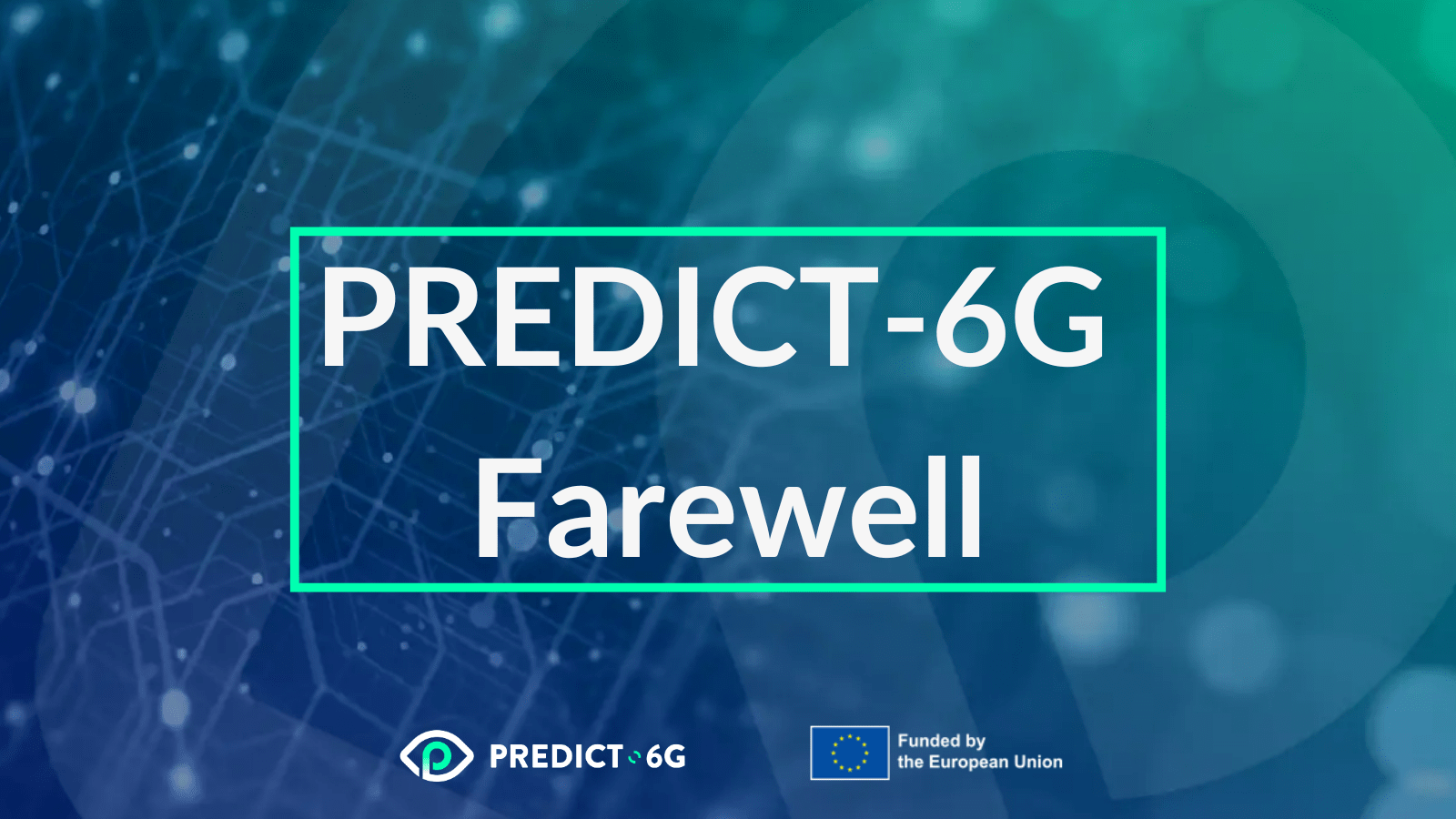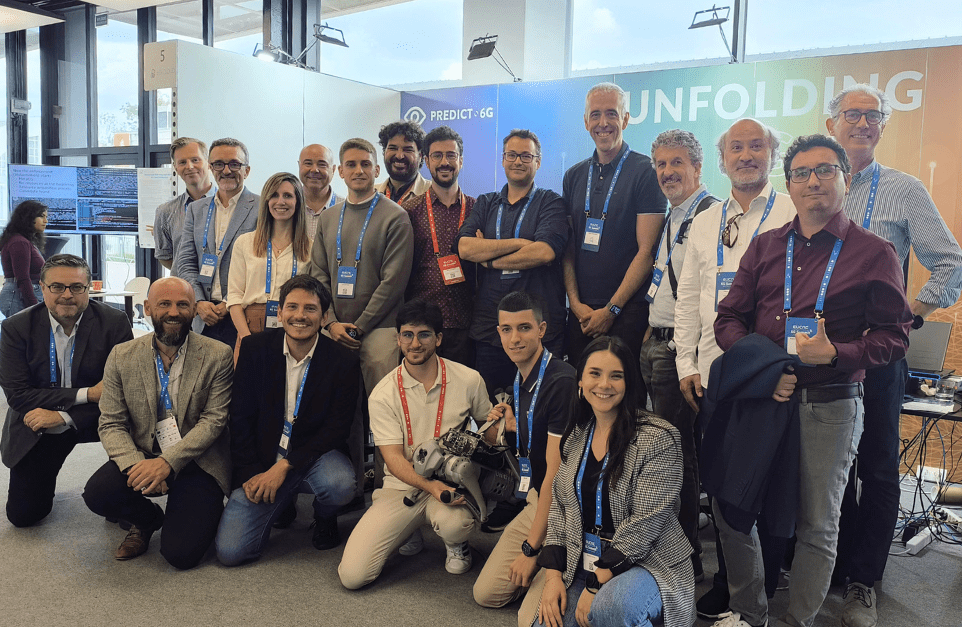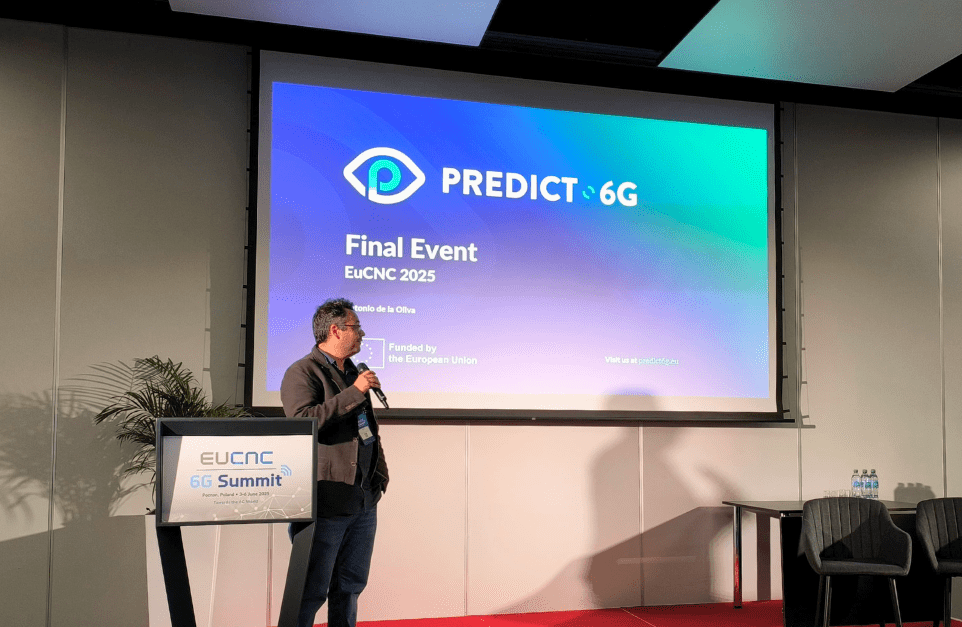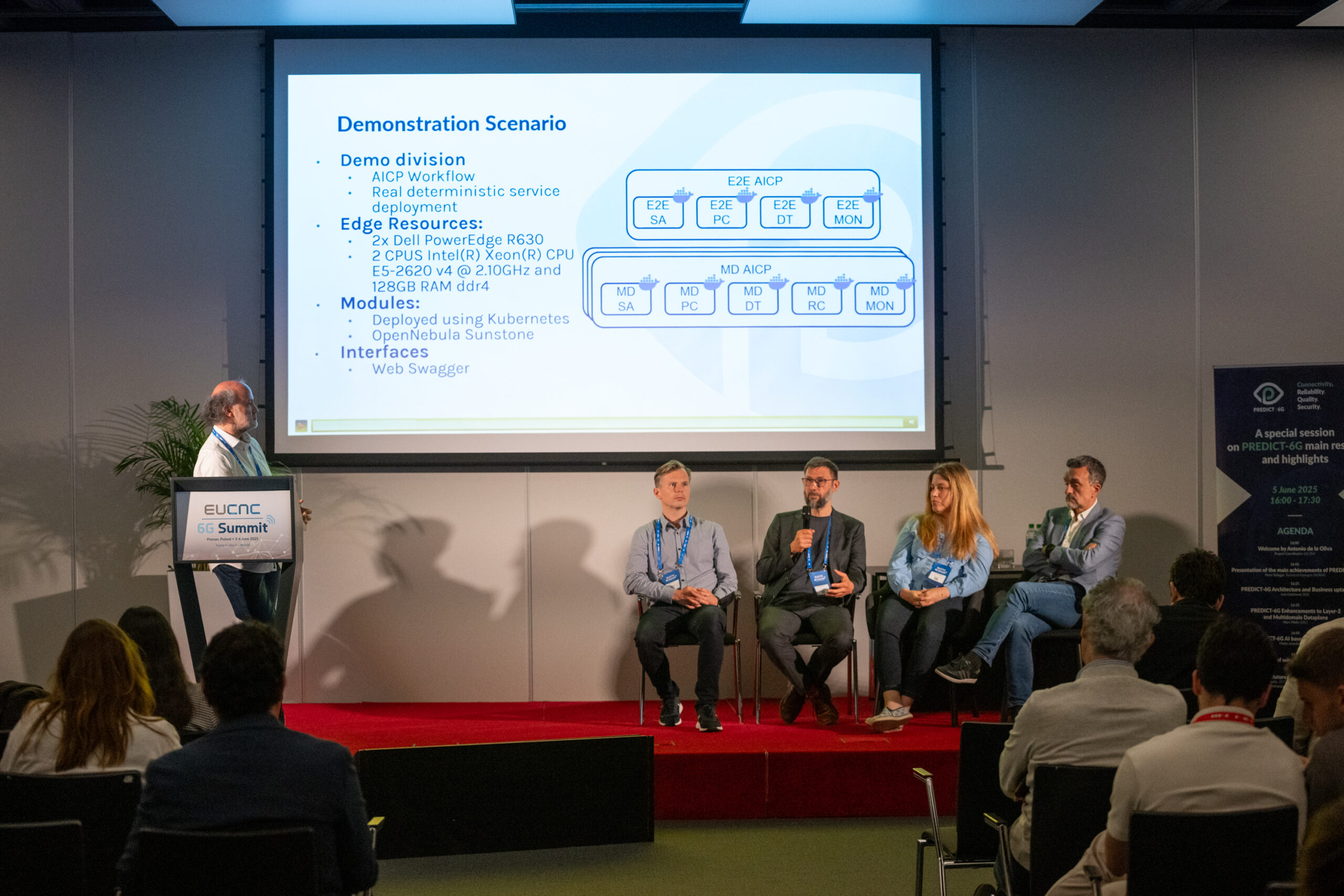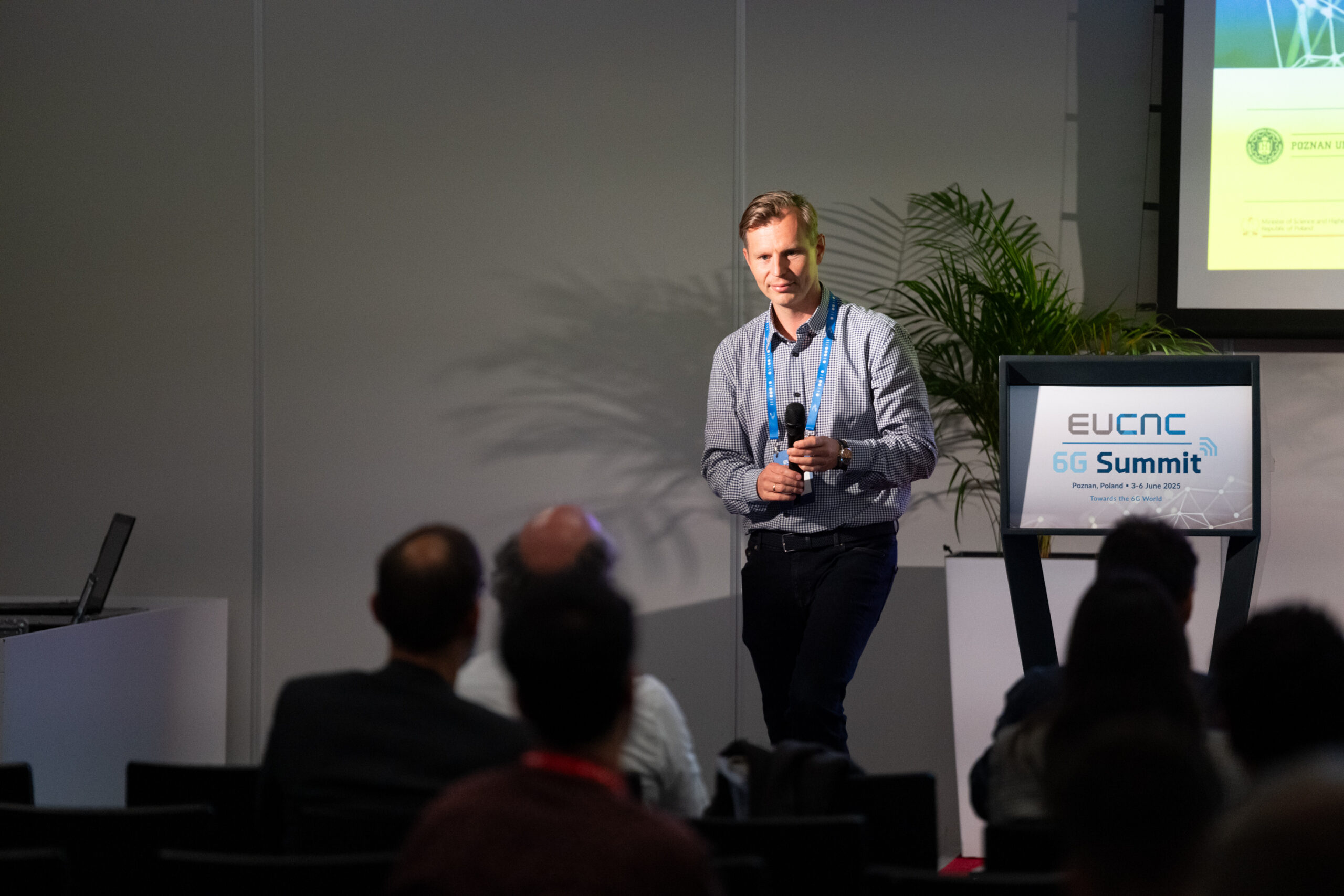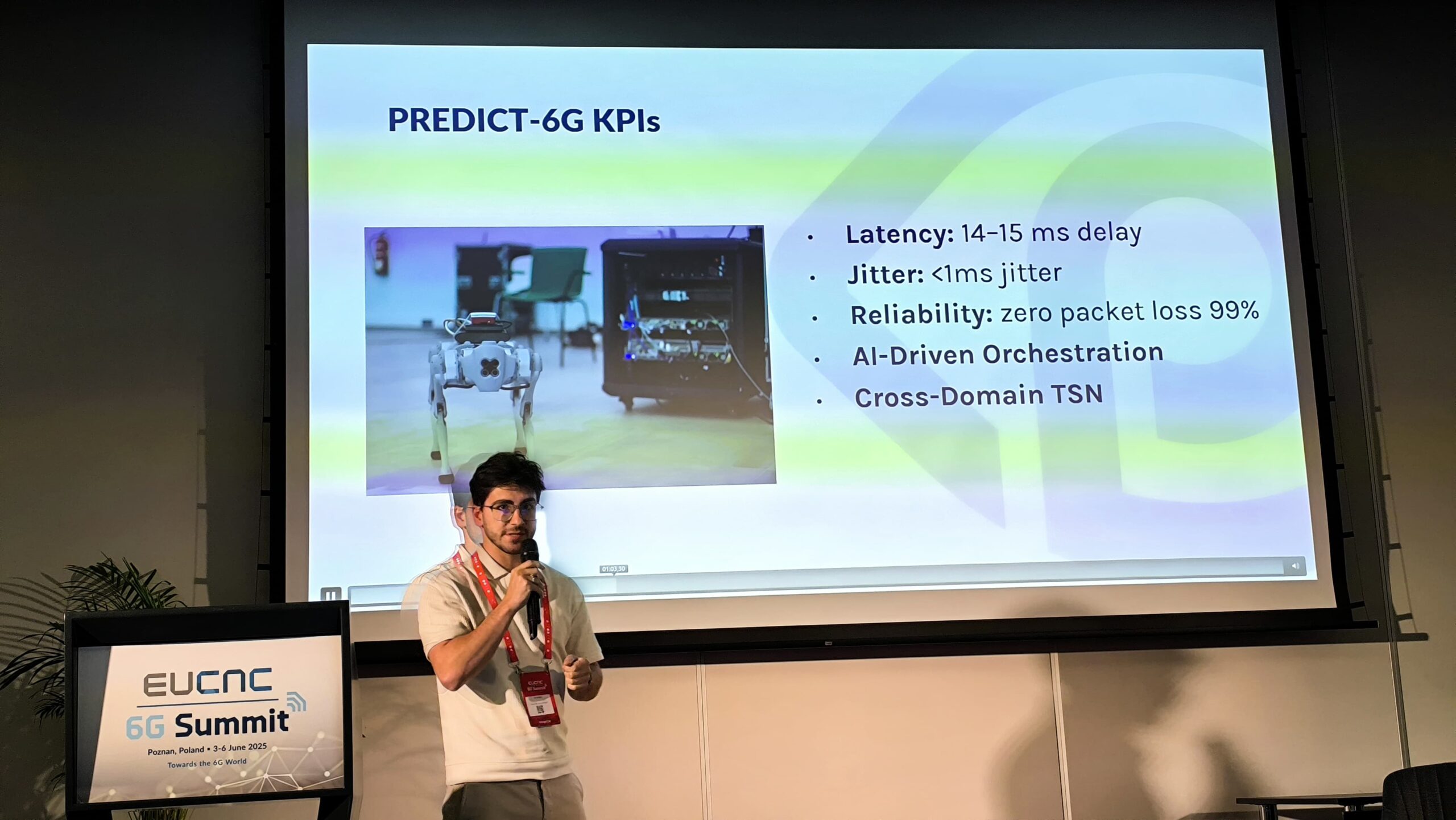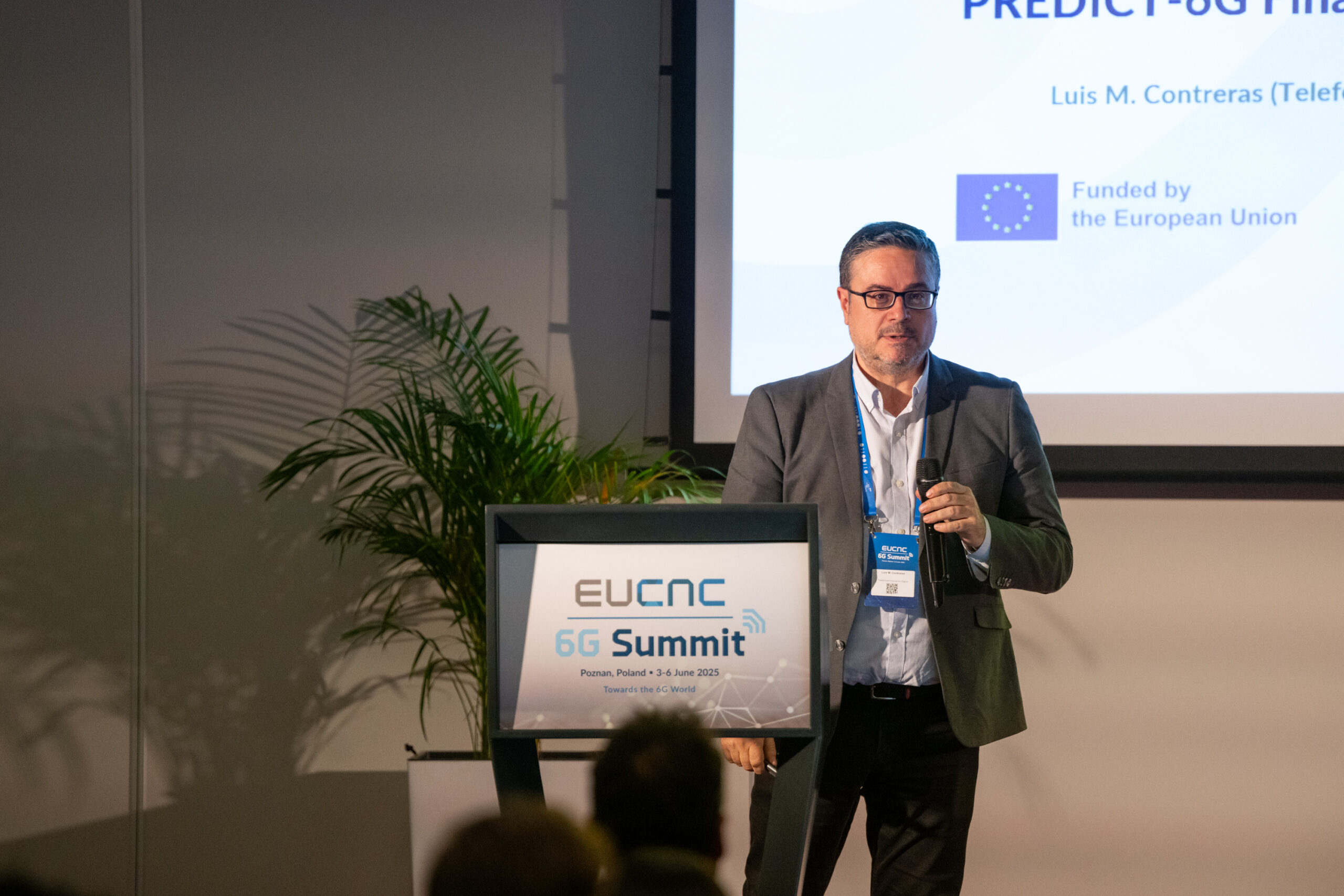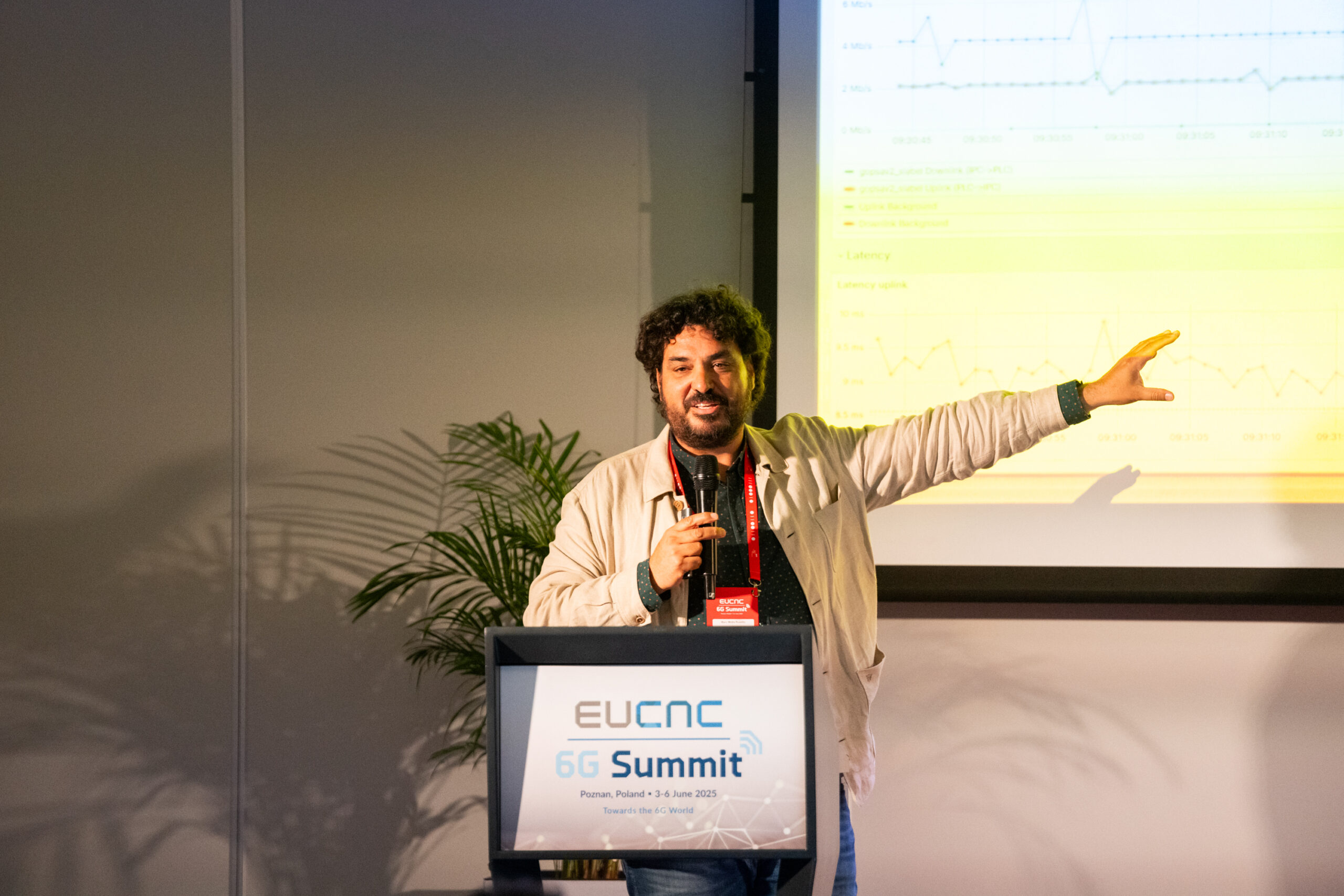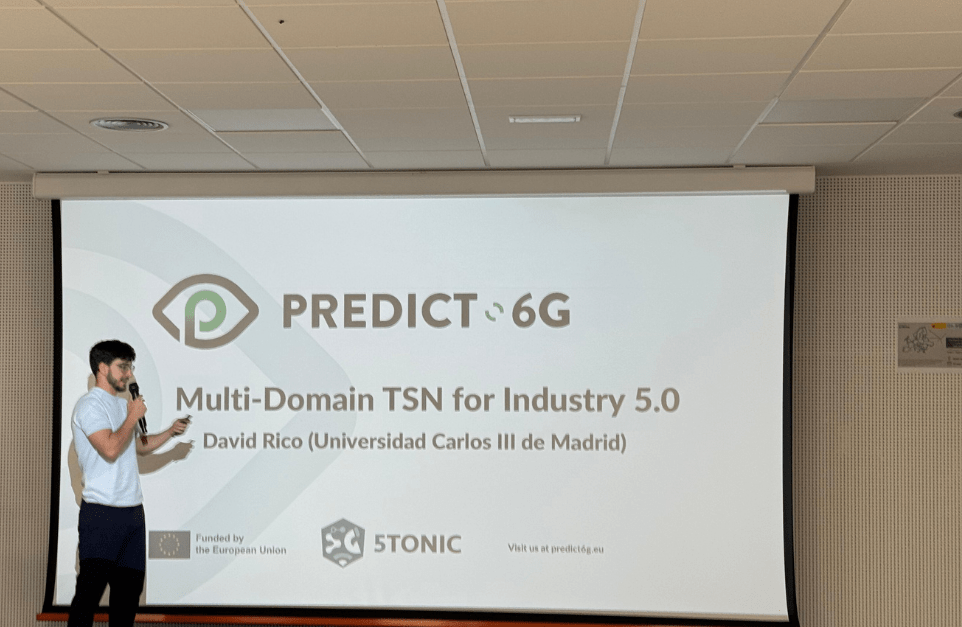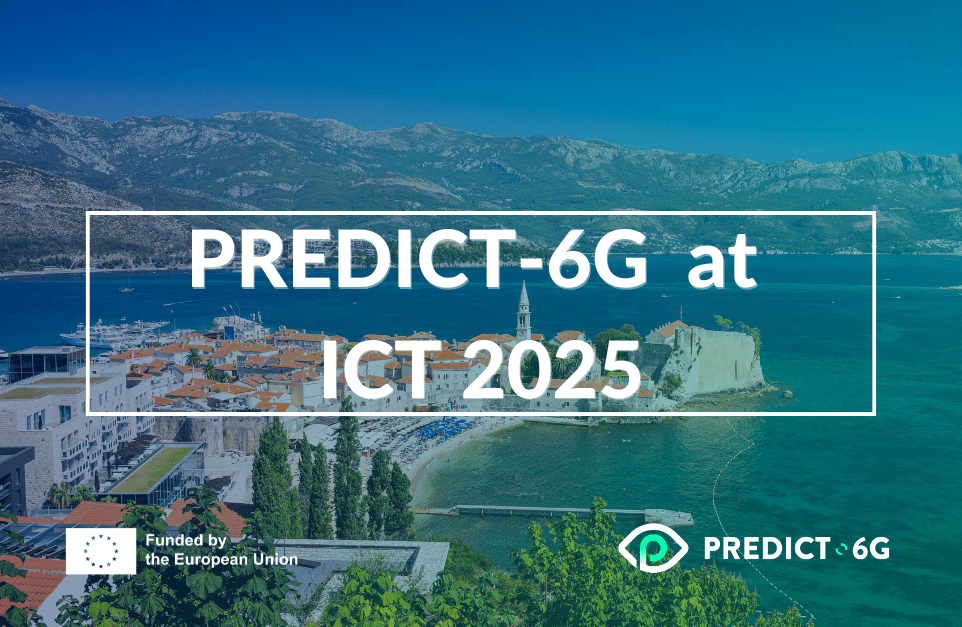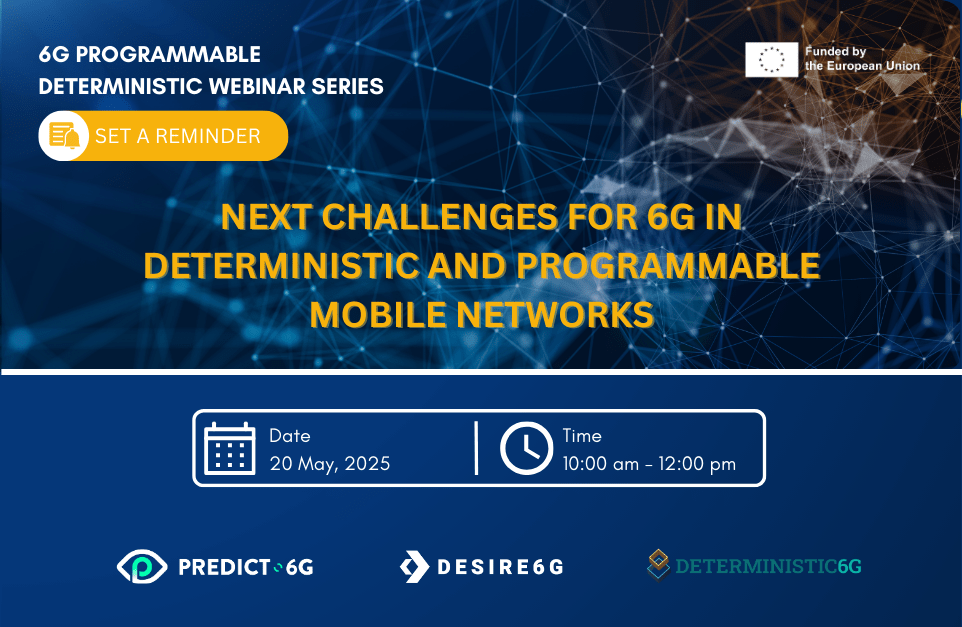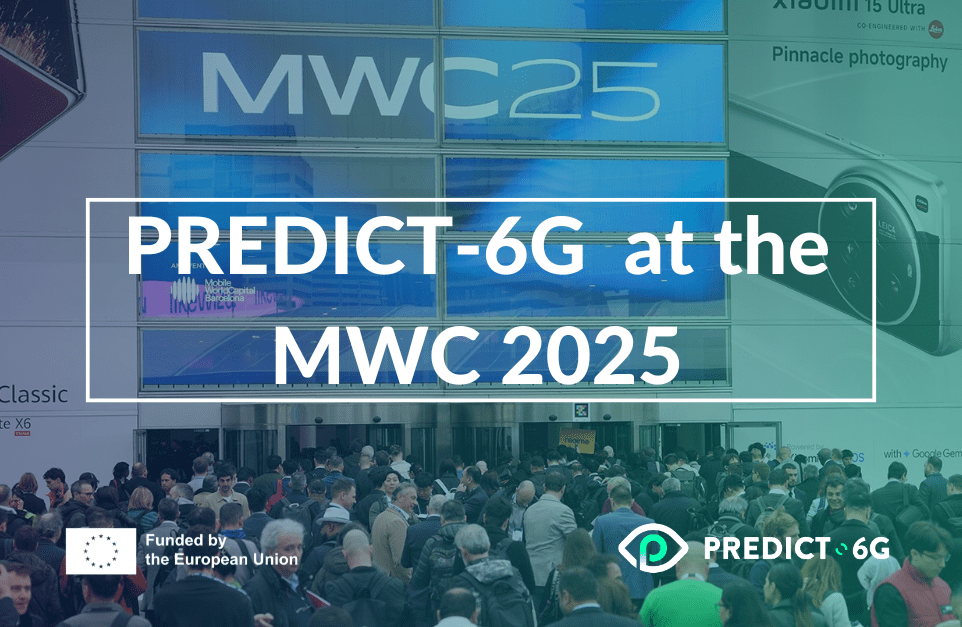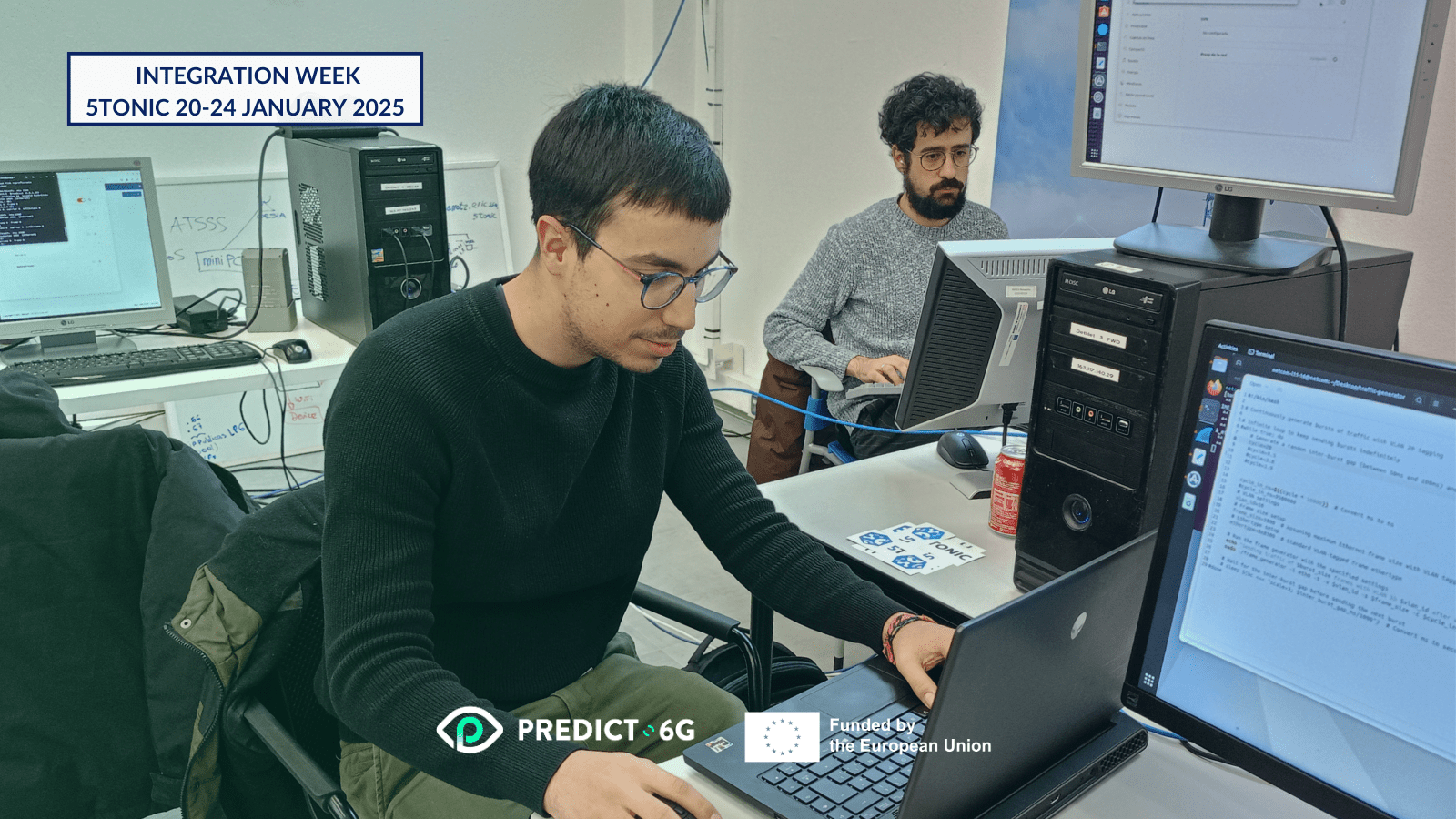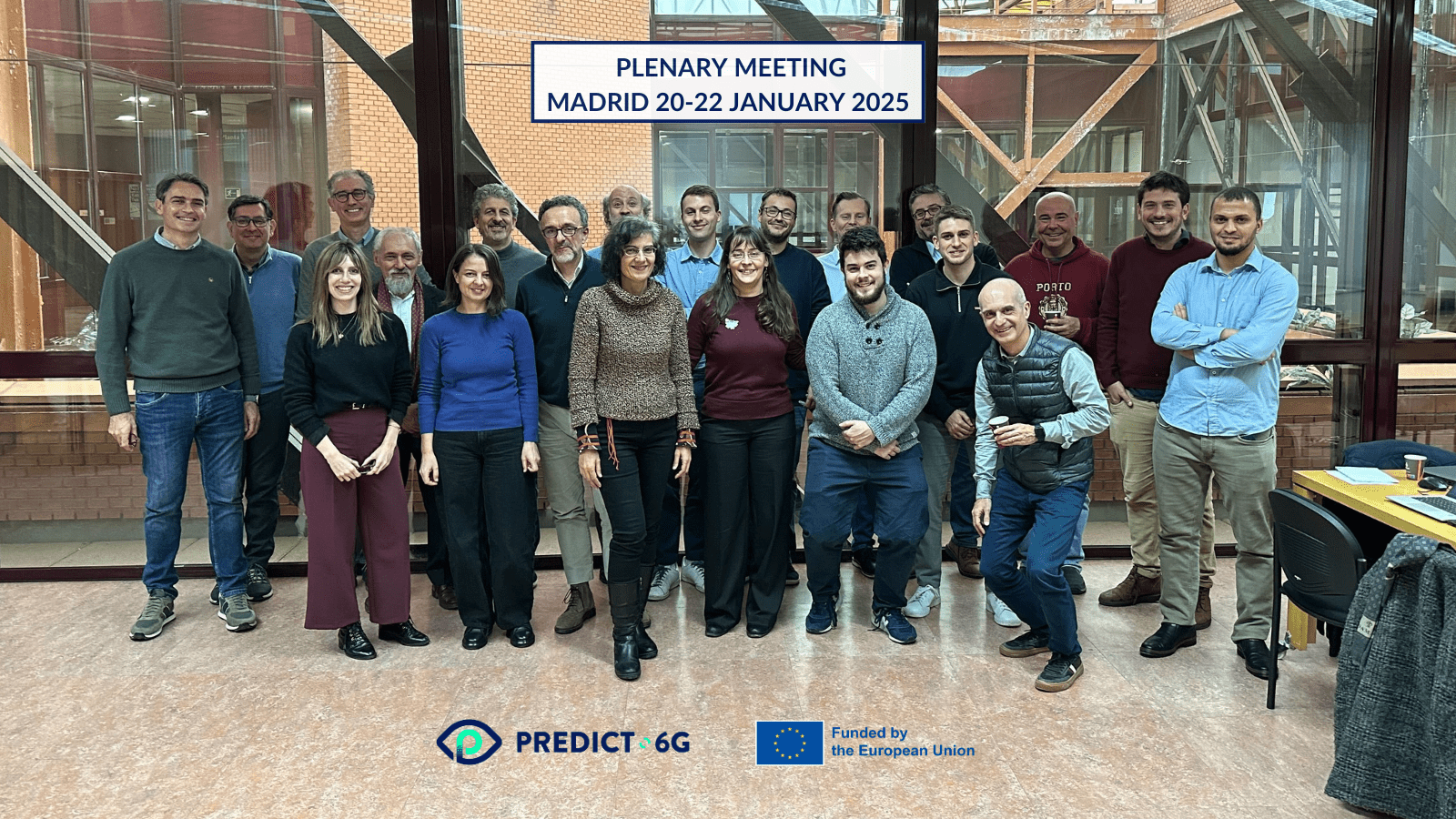PREDICT-6G FAREWELL
With the end of the PREDICT-6G project approaching on 30 June 2025, we asked all our partners what it had been like to be part of the project for almost two and a half years. This is what each partner told us:
Antonio De La Oliva on behalf of Universidad Carlos III de Madrid, PREDICT-6G Coordinator. "As coordinator of PREDICT-6G it has been a pleasure to form part and lead a research project which has advanced significantly the area of determinism in the upcoming 6G network. The research performed, the PoCs developed, and the advance of state of the art achieved will impact next generation networks while, at the same time, training the next generation of network researchers that will shape it. It has been great to work with such an amazing team!"
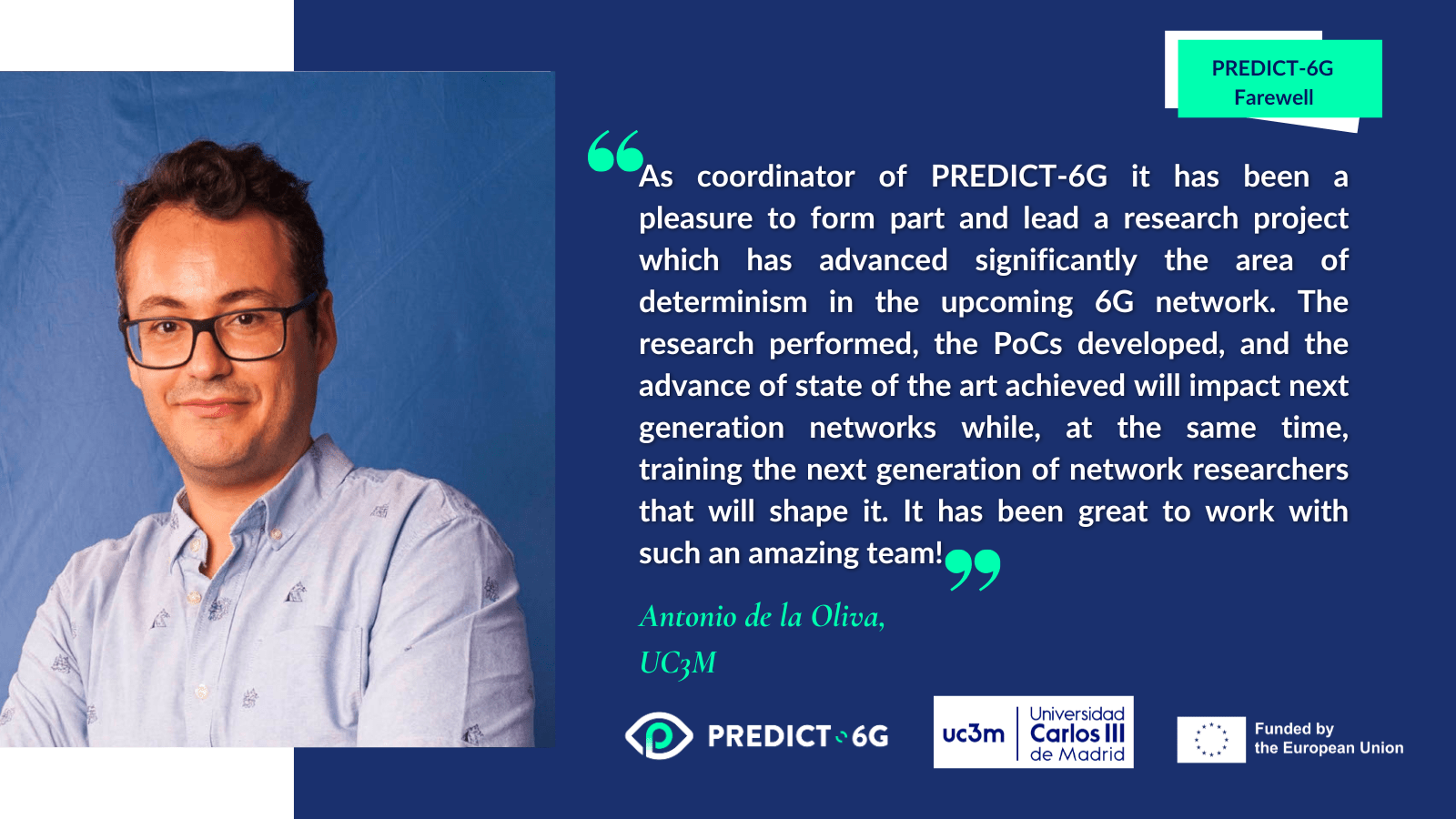
José Luis Cárcel on behalf of Atos, leader of the PREDICT-6G ‘Frictionless inter-domain orchestration and network control’ task. "PREDICT-6G has been an exciting journey for Atos. It has been a great opportunity for us to extend our work on MLOps and Service Automation to help the project achieve the predictability and reliability required to guarantee determinism".
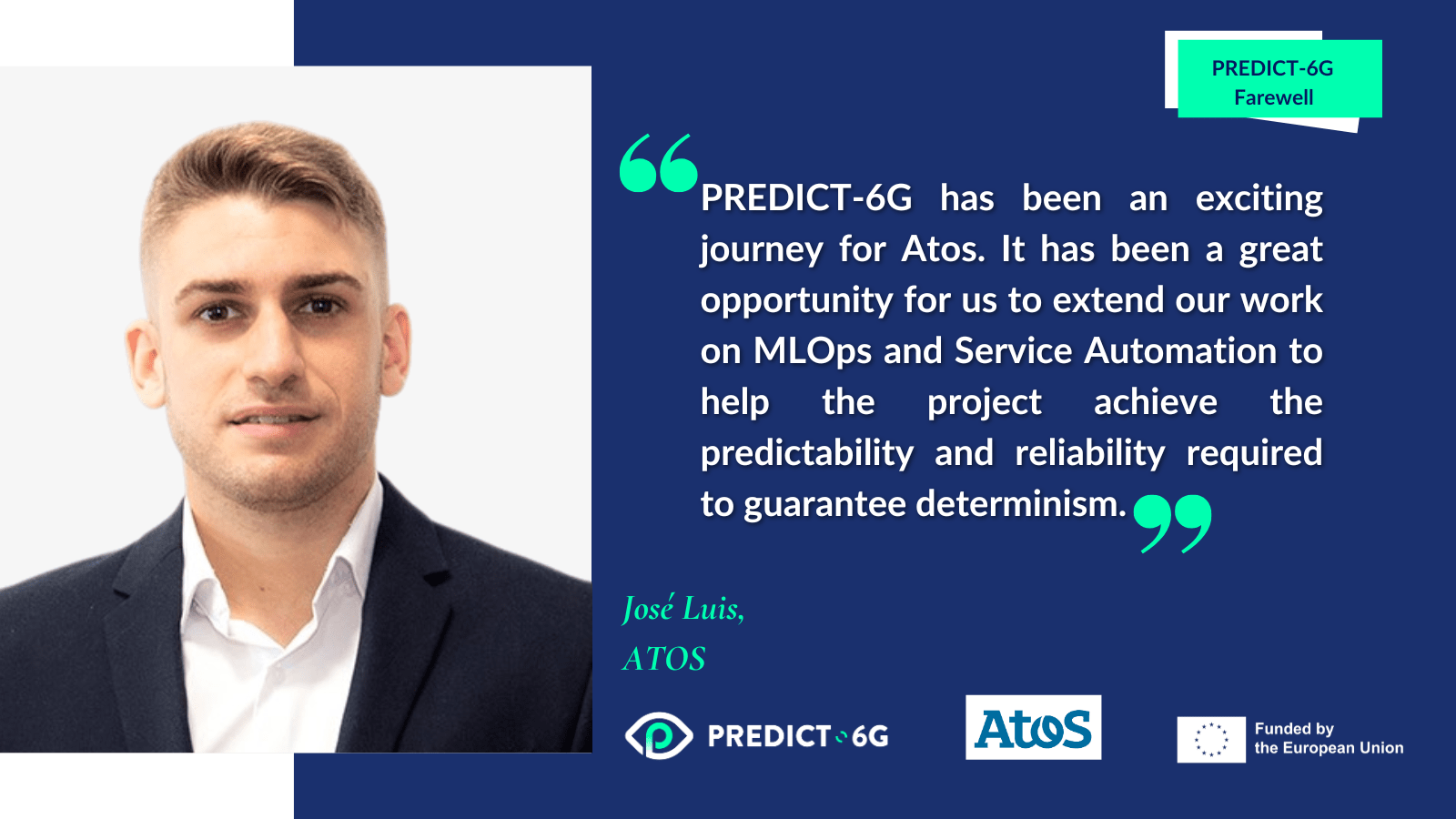
Jessica Carneiro on behalf of AUSTRALO, PREDICT-6G Dissemination and Communication Task Leader."Witnessing the practical application of the PREDICT-6G determinism concept across multiple sectors was enlightening.For AUSTRALO, it was rewarding to creatively translate complex project elements such as AICP or MDP into engaging content that showcased the project's achievements".

Fotis Foukalas on behalf of Cogninn, the partner responsible for overseeing the security aspects of the PREDICT-6G network. "The role of security for PREDICT-6G is important. Cogninn in collaboration with other partners specified secure multi-domain authentication and other security mechanisms for PREDICT-6G type of management architectures for future 6G networks".
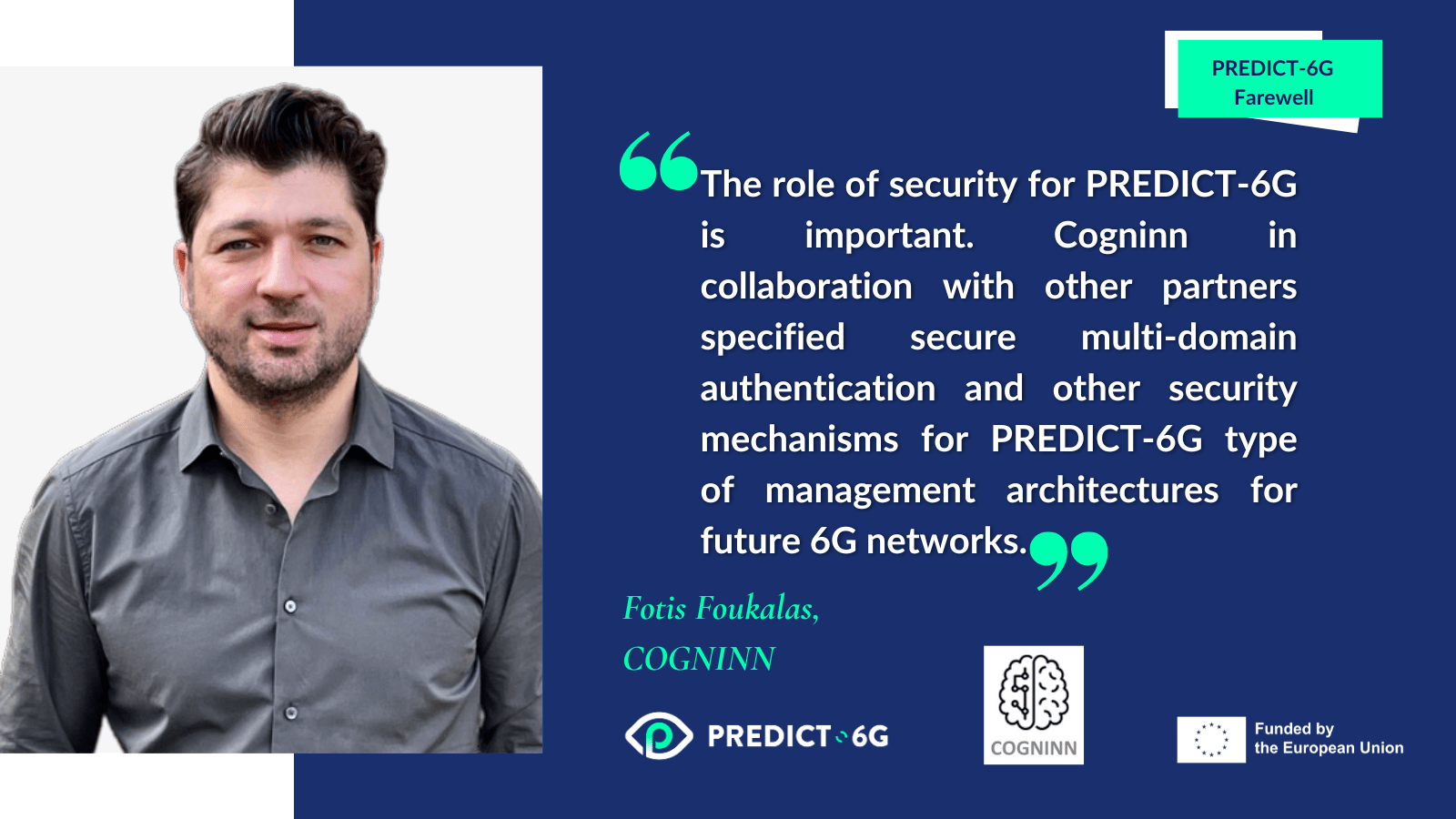
Claudio Zunino on behalf of the Consiglio Nazionale delle Ricerche (CNR). CNR contributed to the development of the core components of the PREDICT-6G network and validated its architecture in a critical use case at the Budapest Open Lab. "The participation in the PREDICT-6G project revealed an exciting and profitable chance. In this context, the CNR team had the opportunity of practically experiencing the usefulness of topics like TSN and SDN, that were formerly only theoretically addressed, and to check the benefits they brought to the determinism requested by the project".
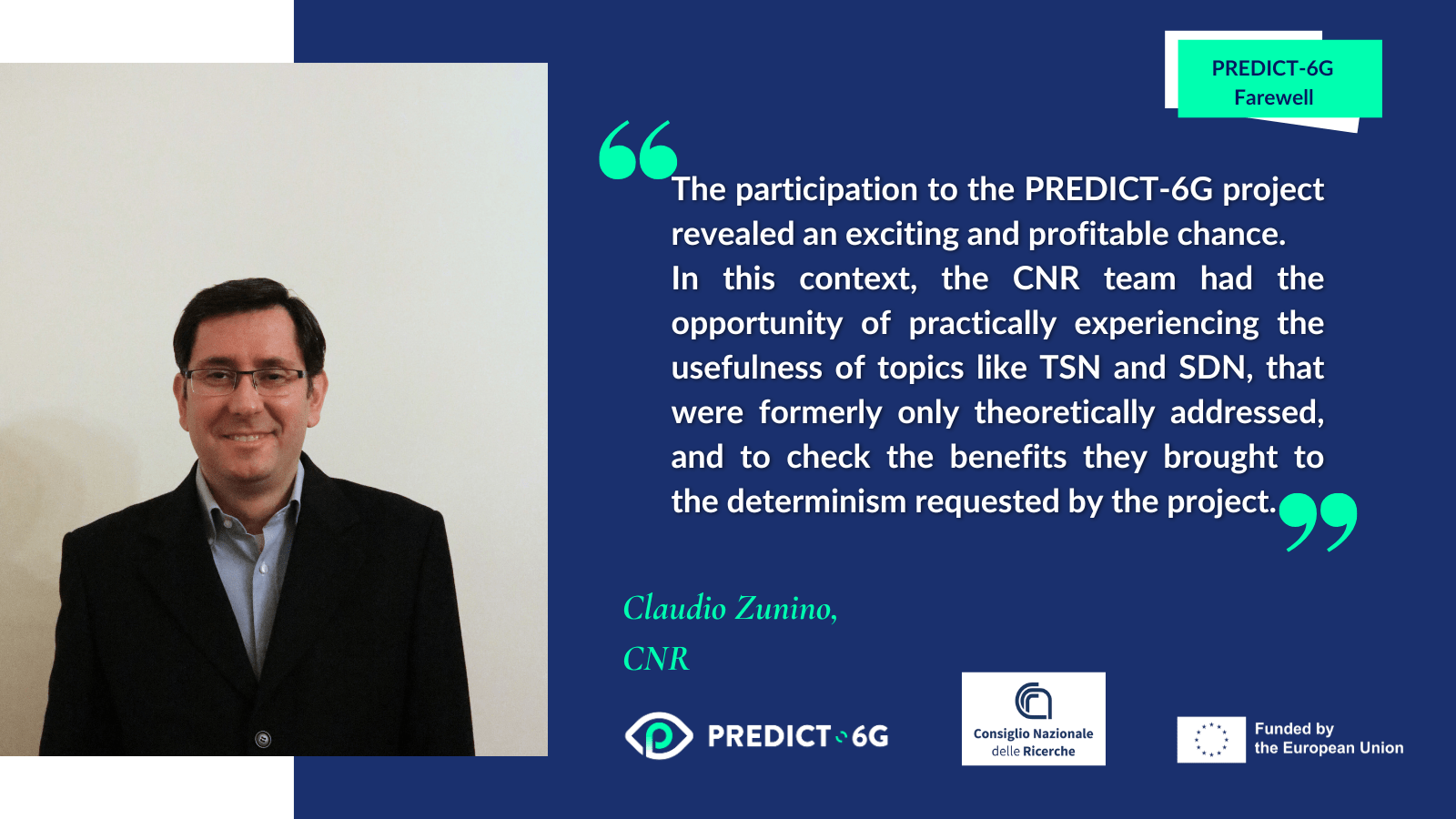
Miguel Ángel López on behalf of Ericsson, leader of the PREDICT-6G Multi-technology multi-domain Data-Plane Work Package. "It has been amazing to see how the PREDICT-6G determinism technologies can impact industry and society. From Ericsson's perspective, we are focused on demonstrating how mobile technologies such as 5G can transform industries that are traditionally wired and where determinism is a must".
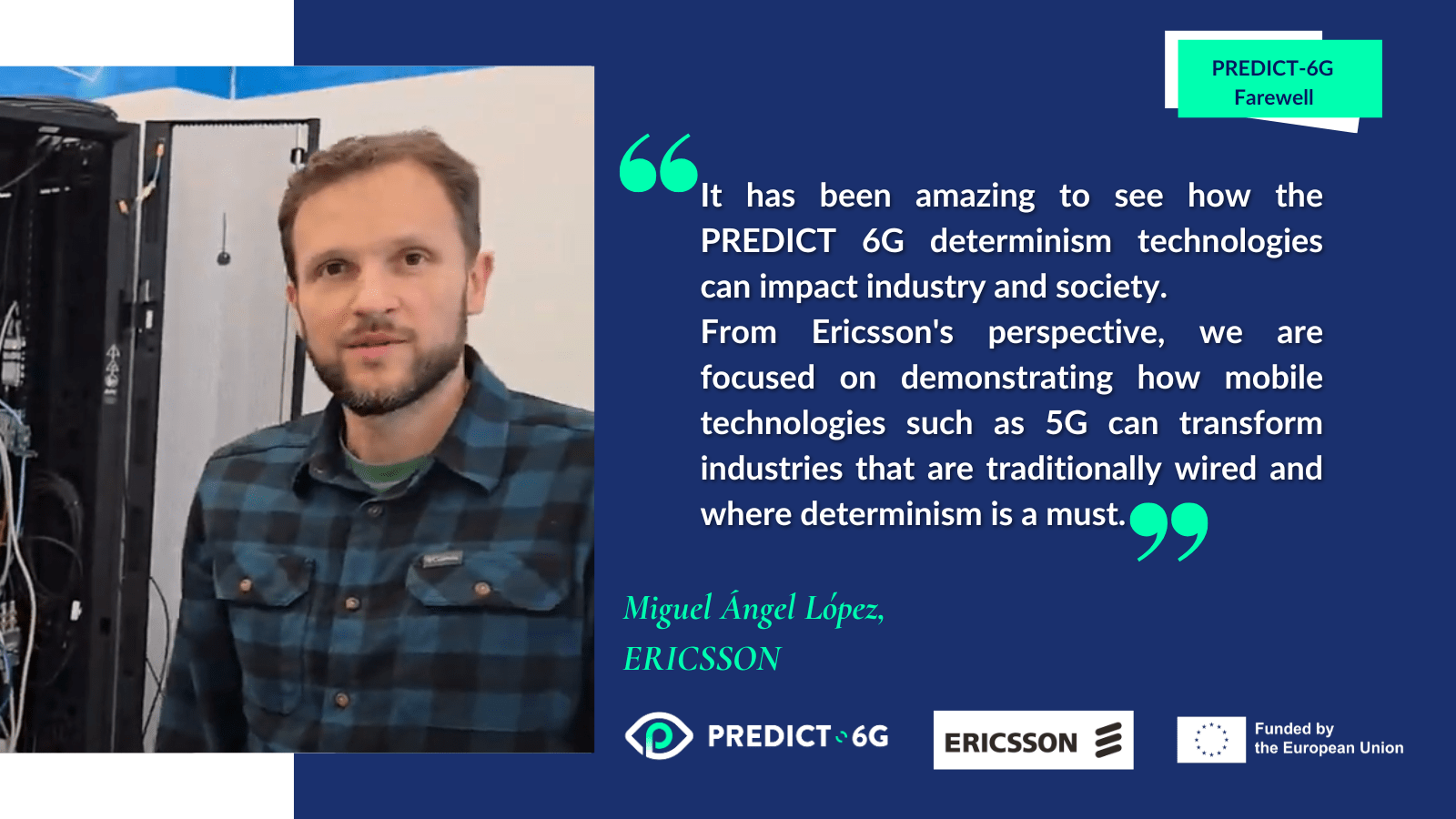
Josu Caminos on behalf of Gestamp, part of the PREDICT-6G Smart Factory use case. "Deterministic wireless communications will be a key foundation in GESTAMP’s upcoming Smart Factories, where virtualization and asset mobility will enable complete flexibility and robustness. PREDICT-6G is one step closer to achieving this milestone, where it has been demonstrated that this technology can meet the demanding requirements from industrial environments".
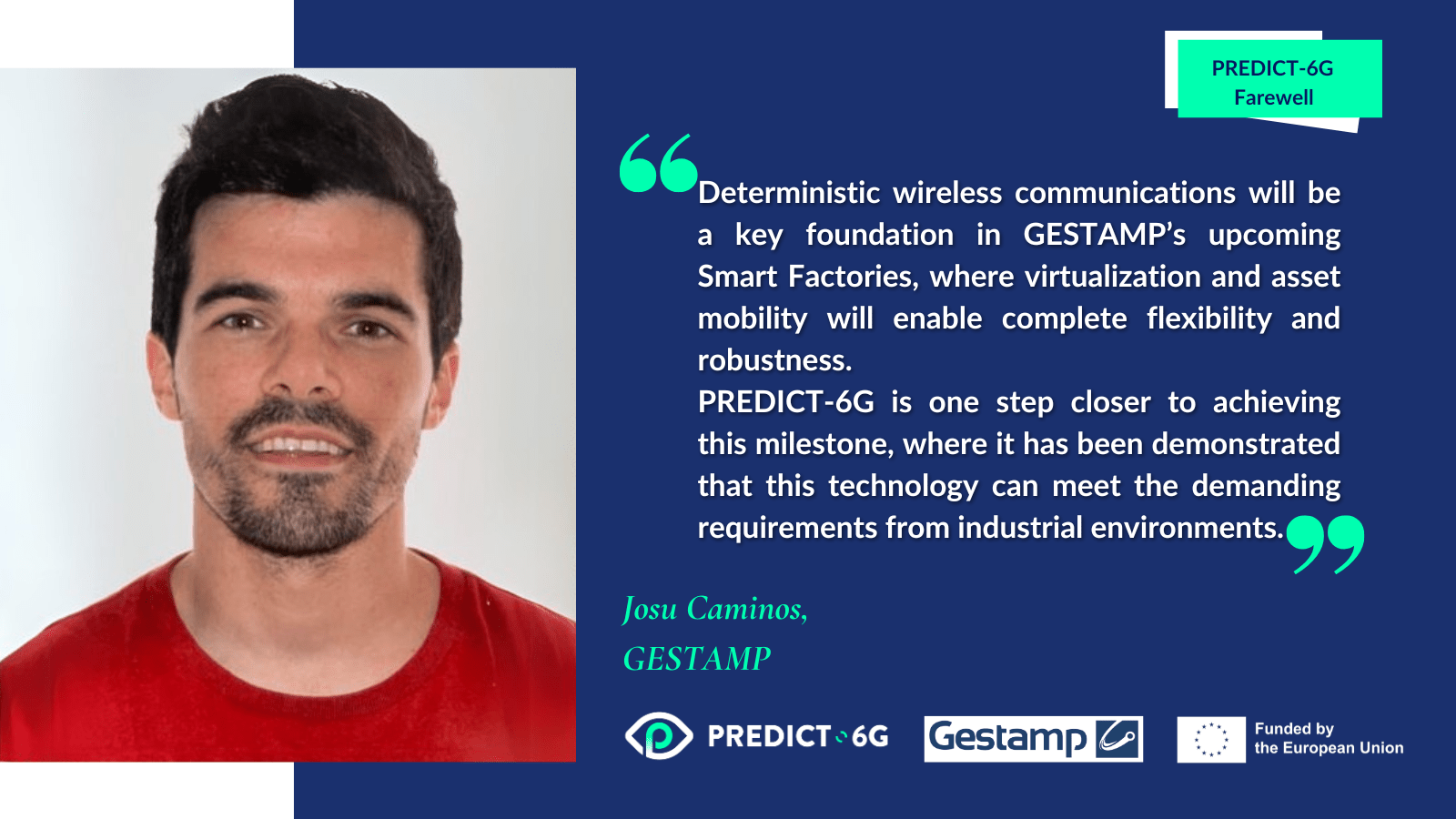
Valerio Frascolla on behalf of Intel, leader of the PREDICT-6G Impact Creation Work Package. "Disciplined Innovation in research projects is key for obtaining outstanding results. That is why Intel is driving the PREDICT-6G Innovation Program, e.g. organizing workshops where fun and learning go hand in hand".
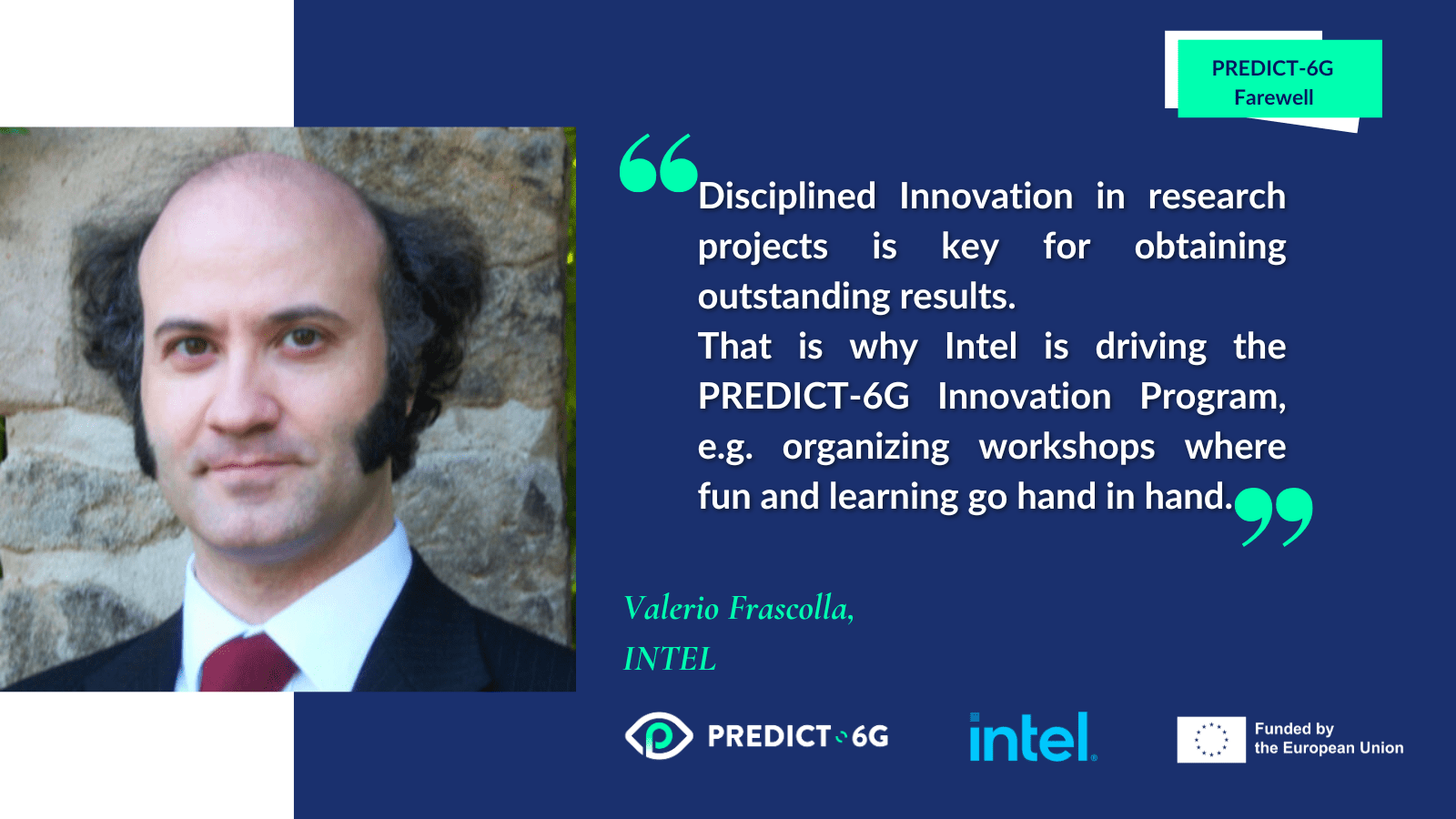
Sebastian Robitzsch on behalf of InterDigital, and responsible for the standardisation of PREDICT-6G. "During the lifetime of the project, we had the opportunity to develop a standards-aligned deterministic IPv6-compliant data plane concept and integrated it successfully with PREDICT-6G partners in a multi-domain localisation and sensing use case".
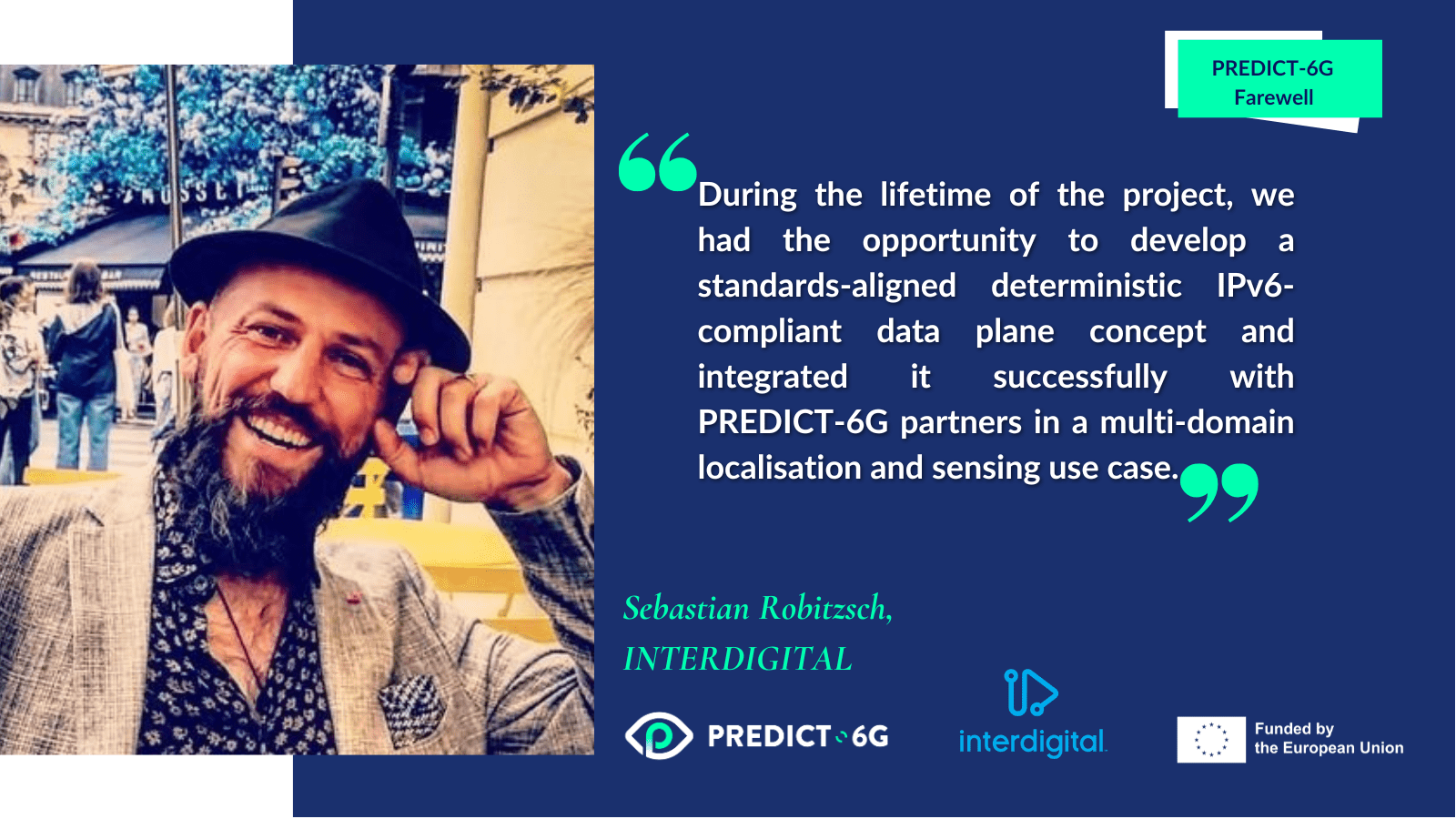
Matteo Ravalli on behalf of Nextworks, PREDICT-6G Monitoring Platform and Data Management for deterministic networks task leader. "The goal of PREDICT-6G has been challenging and working together to achieve it has been exciting. It has been a great chance for Nextworks to improve our Data Collection and Management module with an extended architecture and new features for the monitoring of meaningful metrics from the MDP needed for data-driven network automation decisions".
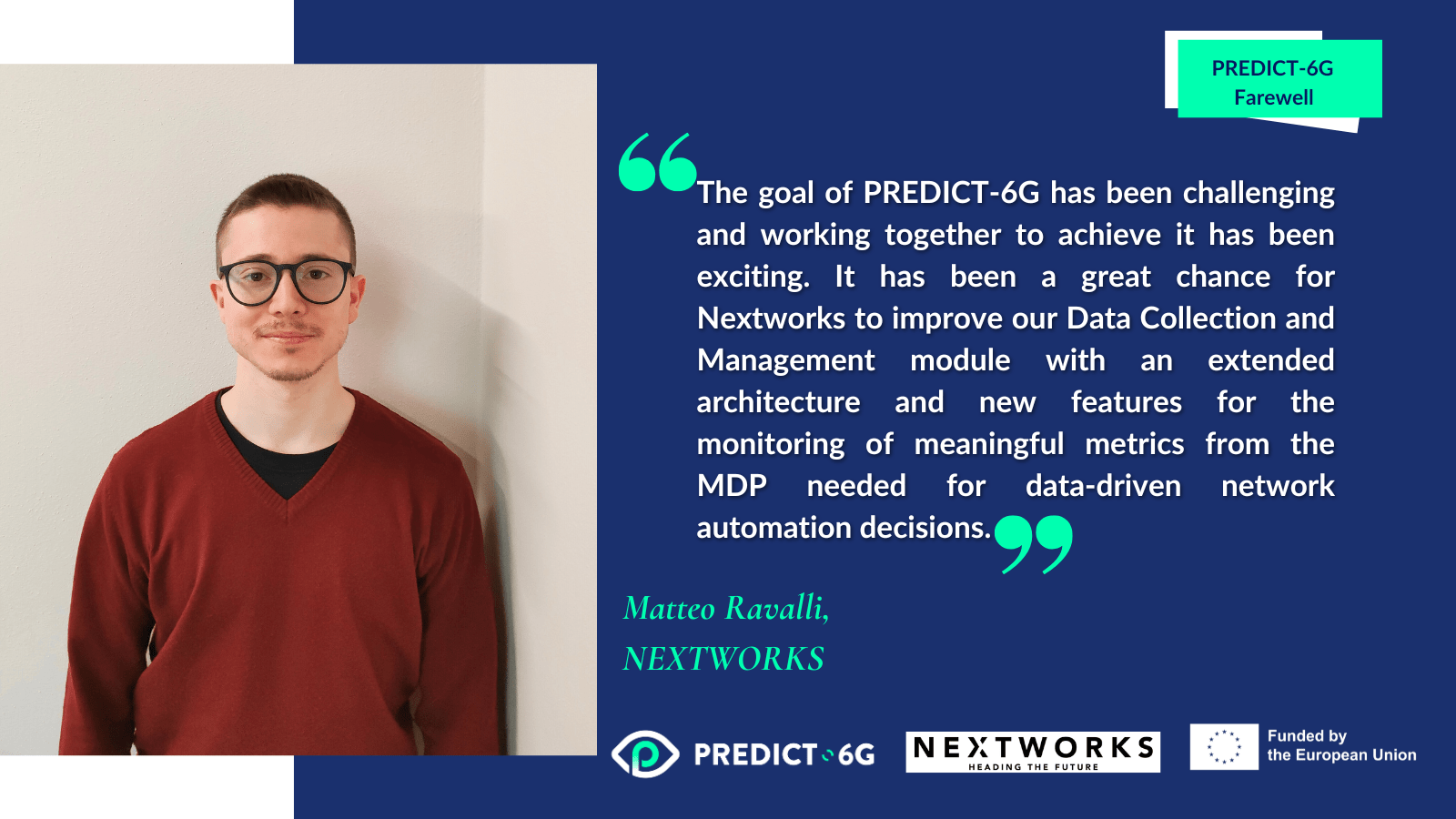
Zoltán Vincze on behalf of Nokia, leader of the PREDICT-6G task called 'definition of the system architecture'. "PREDICT-6G's work was an important step towards enabling use cases requiring deterministic communication. As part of this, we had the opportunity to work on a solution that can improve the level of determinism in networks with no in-built deterministic capabilities, thus making it possible to reuse existing install base of non-deterministic enabled network devices on the path of transitioning to an E2E deterministic-enabled stack".
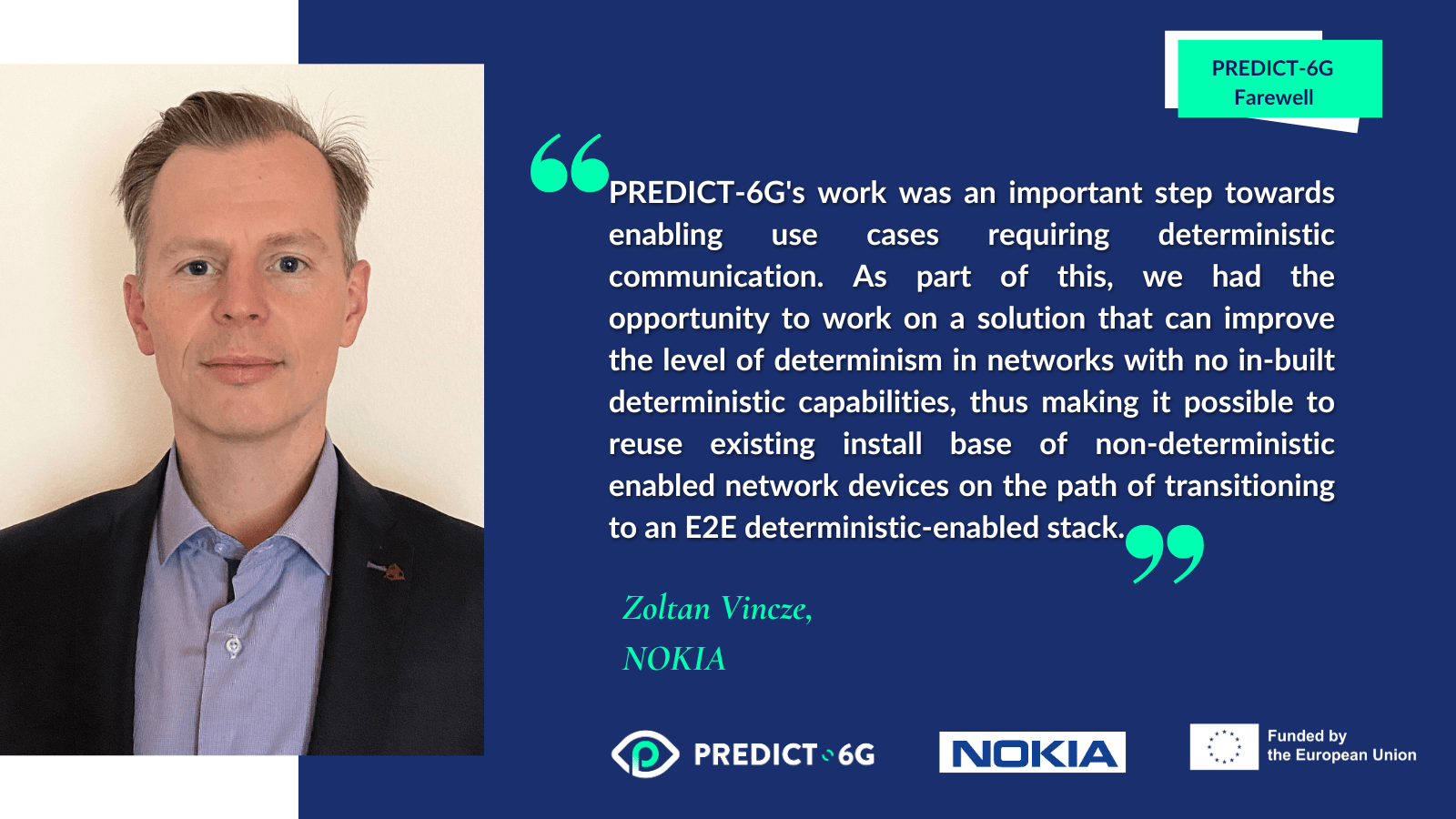
Corrado Puligheddu on behalf of Politecnico di Torino, leader of the PREDICT-6G task called 'Algorithmics for predictability and resource allocation in multi-domain environments'. "At Politecnico di Torino, we are glad to have contributed to PREDICT-6G, tackling the challenge of network determinism in future 6G networks. We are proud that our research efforts show promise for real-world application and hold the potential to create meaningful impact for society".
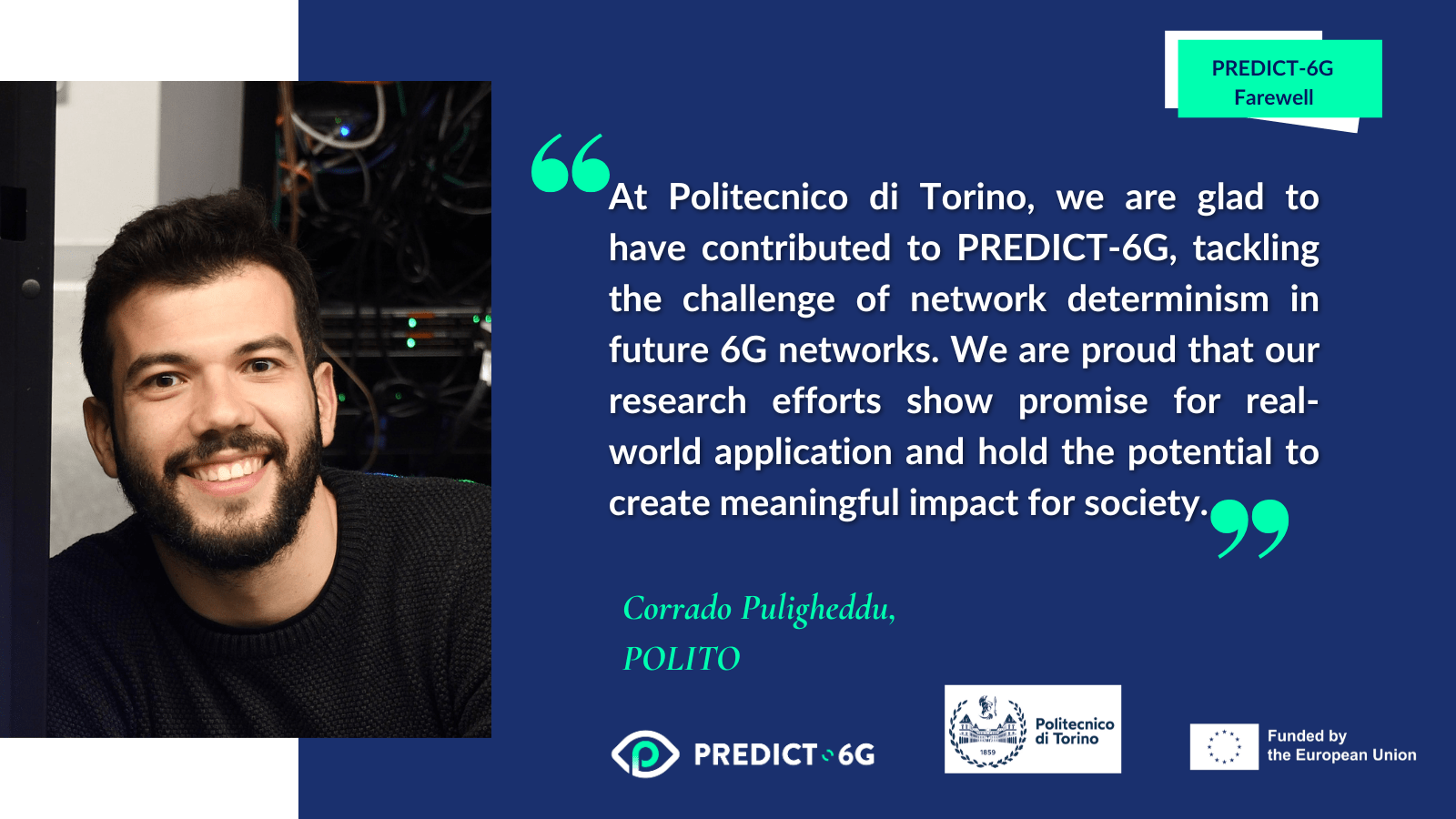
Iacob Crucianu from SIMAVI, and leader of the PREDICT-6G Integration and use case verification Work Package. "As part of the PREDICT-6G project, SIMAVI has proposed a redundancy path framework for deterministic and secured 6G networks. Designing and validating this proof-of-concept, while collaborating with a multidisciplinary team was both challenging and rewarding. Thankful to be part of this space of possibilities!".
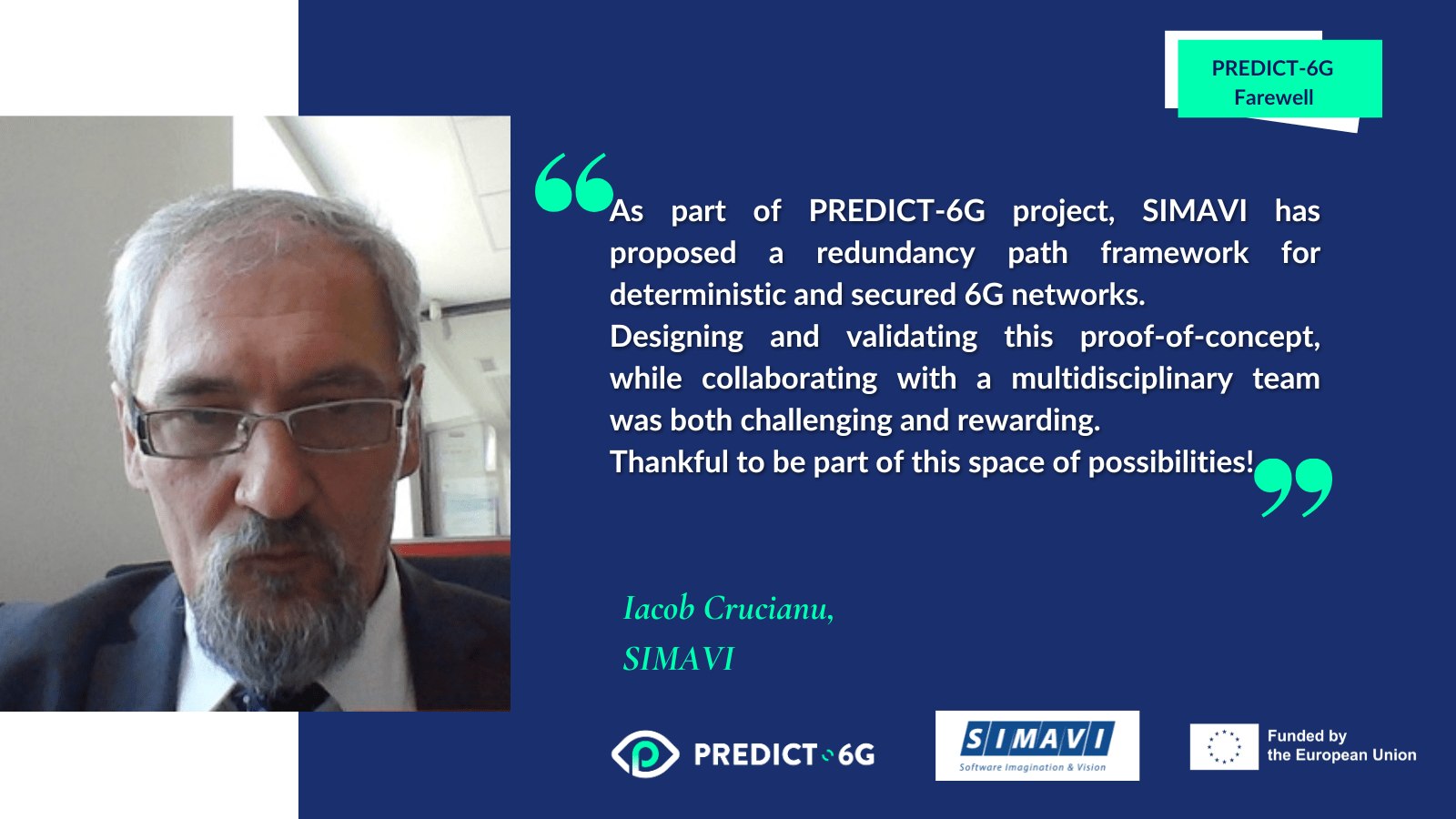
Angelo Cenedese on behalf of Università degli Studi di Padova, a PREDICT-6G partner contributing to the development of the AI-driven multi-stakeholder inter-domain control plane, and to the integration and verification of use cases. "Achieving high performance in multi-device, multi-domain networks requires the co-design of computation, communication, and control across domains. As part of the PREDICT-6G project, UniPD has embraced this integrated approach in the field of mobile robotic applications, paving the way for the development of intelligent, flexible, and scalable networks capable of adapting to and thriving in dynamic environments".
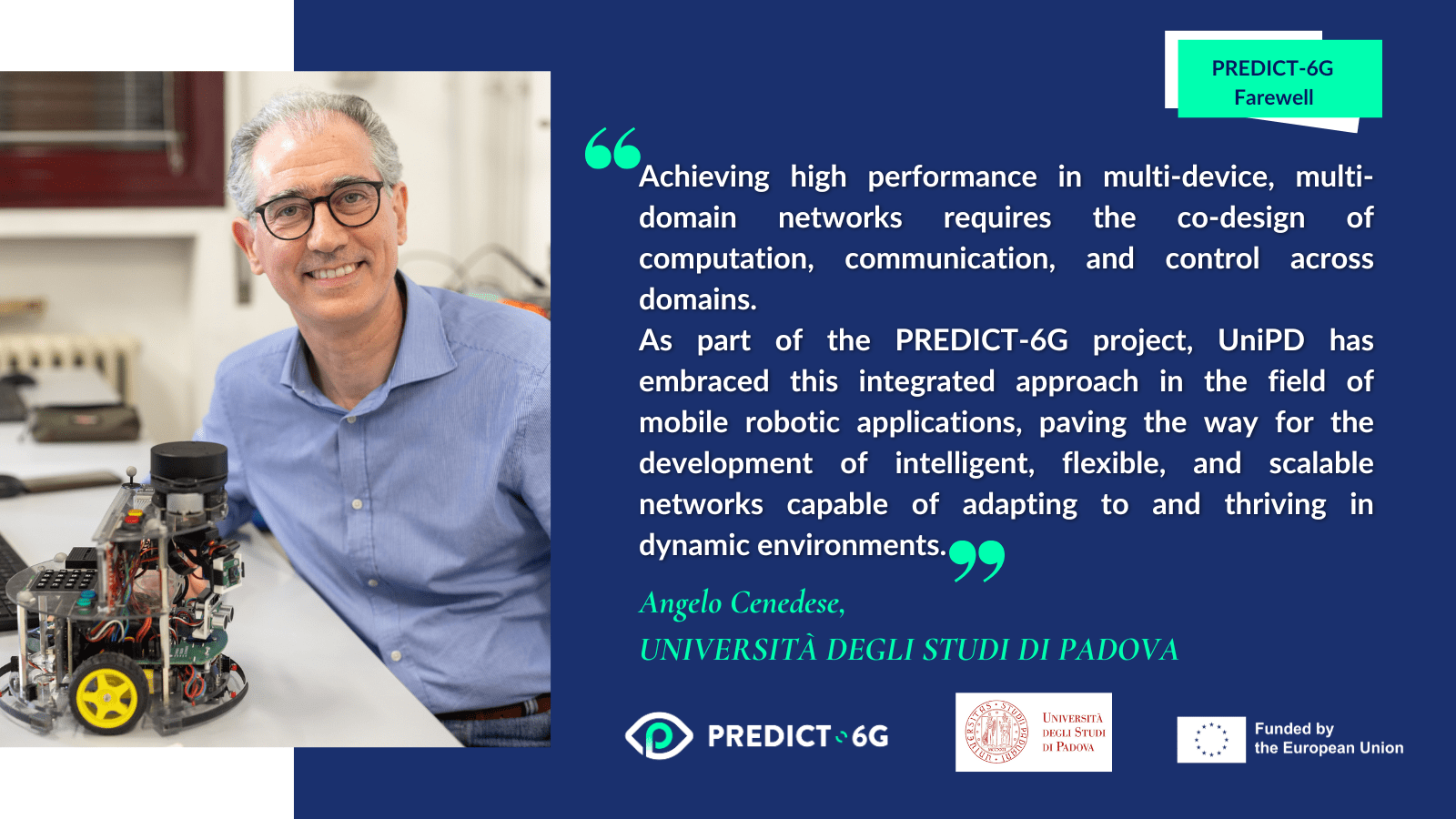
The team from Universitat Politècnica de Catalunya, leader of the PREDICT-6G task called 'Predictability through Digital Twinning Solutions'. "The participation of UPC in Predict6G has been highly valuable, enhancing its research capabilities in deterministic communications, adopting advanced network orchestration and digital twin technologies for industrial automation. It has strengthened academic-industrial collaboration, contributed to scientific advancement, and reinforced UPC’s role in shaping future intelligent, reliable and time-critical systems".
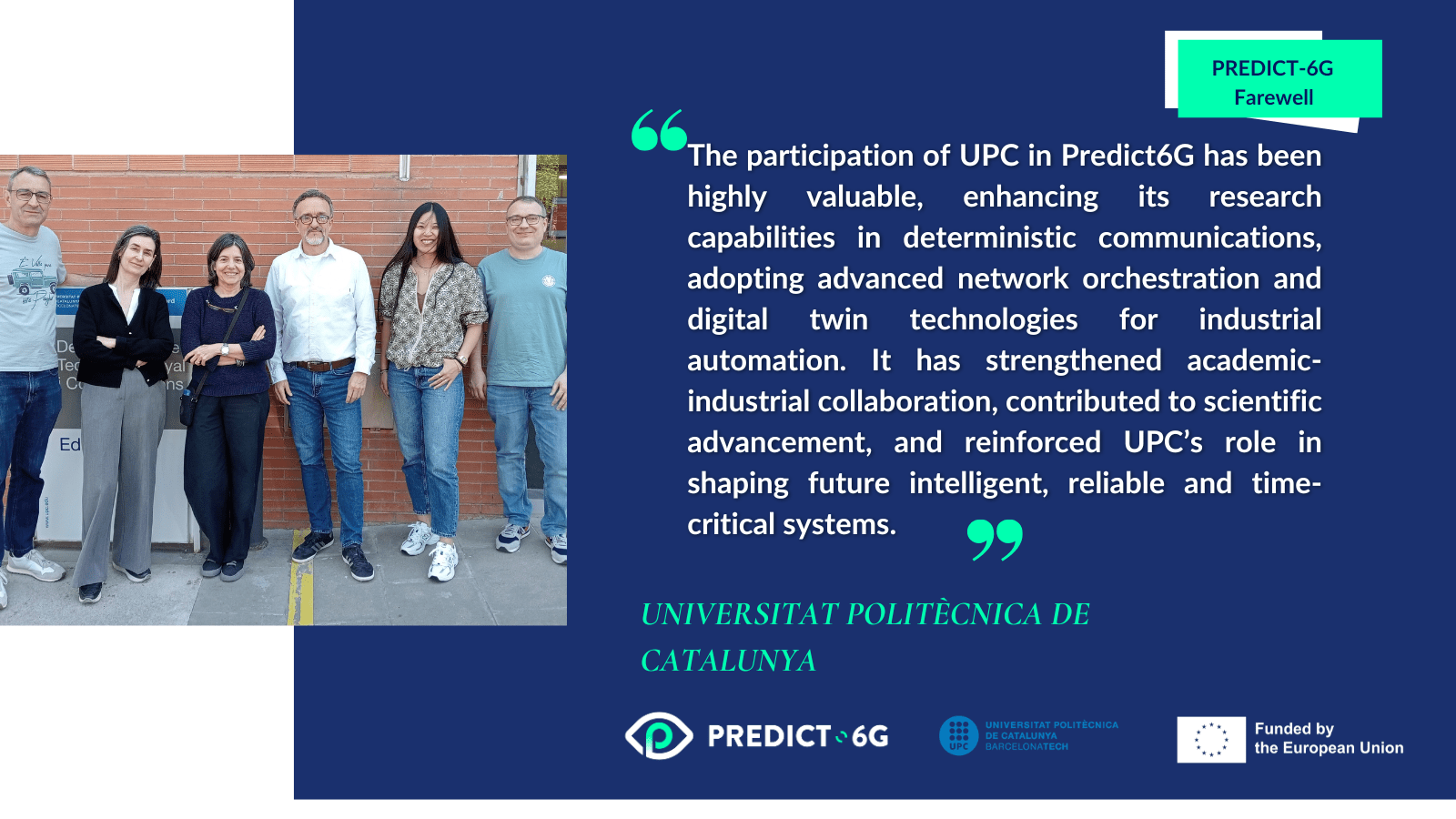
If you want to stay updated about PREDICT-6Gt, subscribe to our newsletter and follow us on Twitter, LinkedIn and Bluesky!
PREDICT-6G at EuCNC & 6G Summit 2025
The 2025 EuCNC & 6G Summit took place from 3 to 6 of June in Poznan, Poland. It brought together cutting-edge research and world-renowned industries and businesses. In recent years, EuCNC has become the event of reference for the telecommunications sector, attracting more than 1,000 delegates from over 40 countries worldwide to present and discuss the latest developments in the industry. The exhibition featured over 50 demos and booths showcasing the newest 6G and SNS technological achievements, developed in the context of the Smart Networks and Services Joint Undertaking (SNS JU) and other EU R&I programmes.
PREDICT-6G participation marked its third consecutive year at the EuCNC & 6G Summit. This edition was especially important as it hosted PREDICT-6G's final event, marking the end of two and a half years of intensive research, development and collaboration within the Horizon Europe SNS JU.
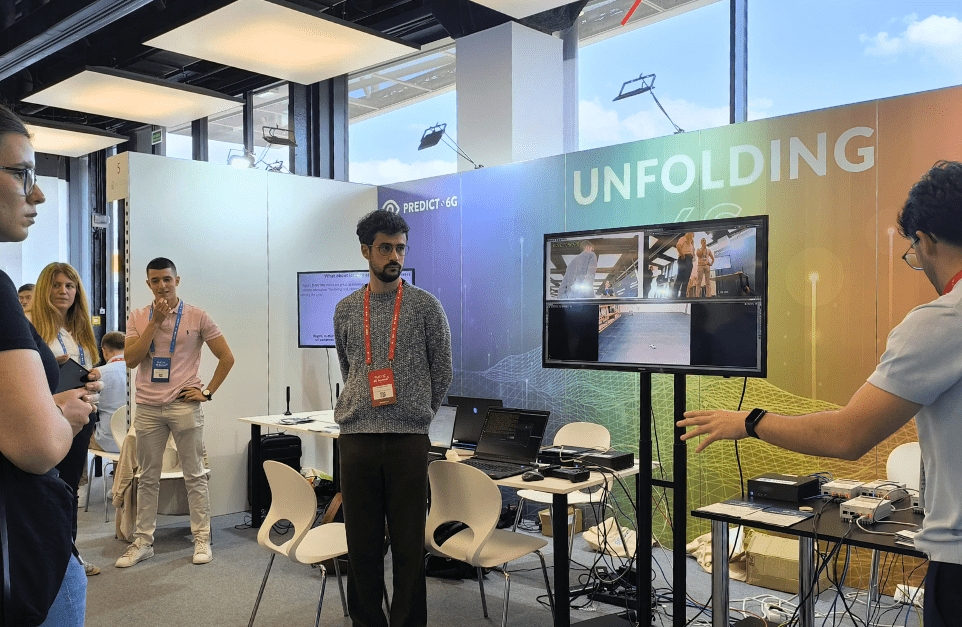
Throughout the four-day event, PREDICT-6G was well represented in various activities and sessions. The project shared an exhibition booth with DESIRE6G and MultiX, providing attendees with a hands-on overview of some of the most impactful technologies developed within the project. Visitors could explore through the different demos how PREDICT-6G contributes to the development of the next generation of deterministic and reliable 6G networks with a focus on multi-domain and multi-technology integration.
On the opening day, PREDICT-6G participated in the workshop titled 'Integrating Network Digital Twinning into Future AI-Based 6G Systems'. Represented by Claudio Casetti from Politecnico di Torino, the project joined a broader discussion involving several EU initiatives: 6G-TWIN, SEASON, DESIRE6G, VERGE, DETERMINISTIC6G, and 6G-SANDBOX. The workshop provided a platform for sharing innovative perspectives on how digital twins can enhance the sustainability, performance and security of networks, which are critical pillars for future 6G infrastructures.
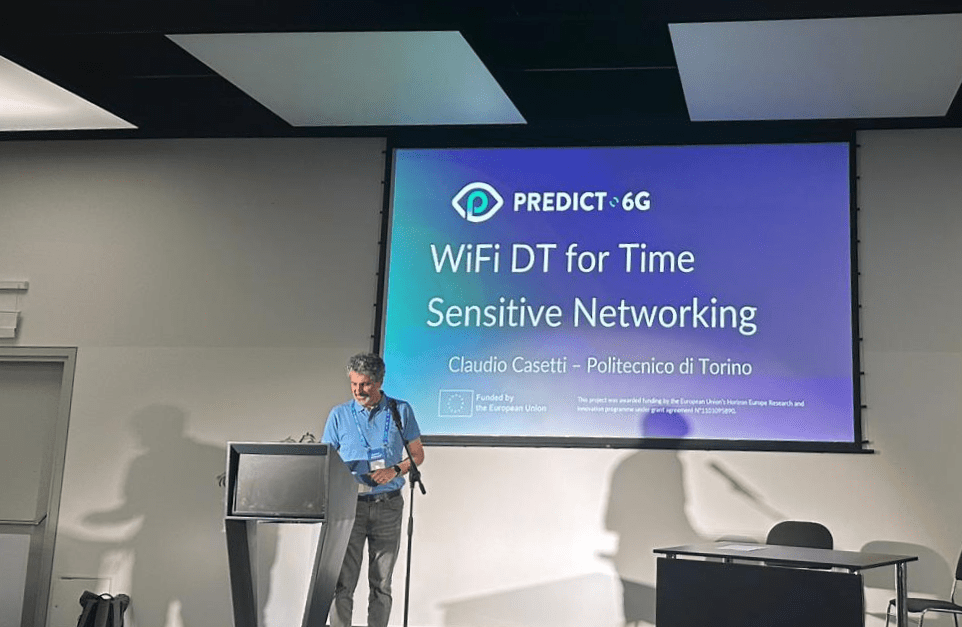
PREDICT-6G's final event
The highlight of PREDICT-6G's presence at EuCNC 2025 was undoubtedly the final event, which took place on 5 June as part of the conference programme. The event began with opening remarks from Antonio de la Oliva, the project coordinator from Universidad Carlos III de Madrid, and Odysseas Pyrovolakis, PREDICT-6G's Project Officer, who formally welcomed the participants and emphasised the importance of the SNS JU in promoting European leadership in 6G technologies. This was followed by an in-depth overview of the project’s main achievements since its launch in January 2023, presented by Zoltán Vincze from Nokia. Luis Miguel Contreras Murillo from Telefónica then offered architectural and business perspectives, providing a strategic view of the project’s long-term impact and relevance.
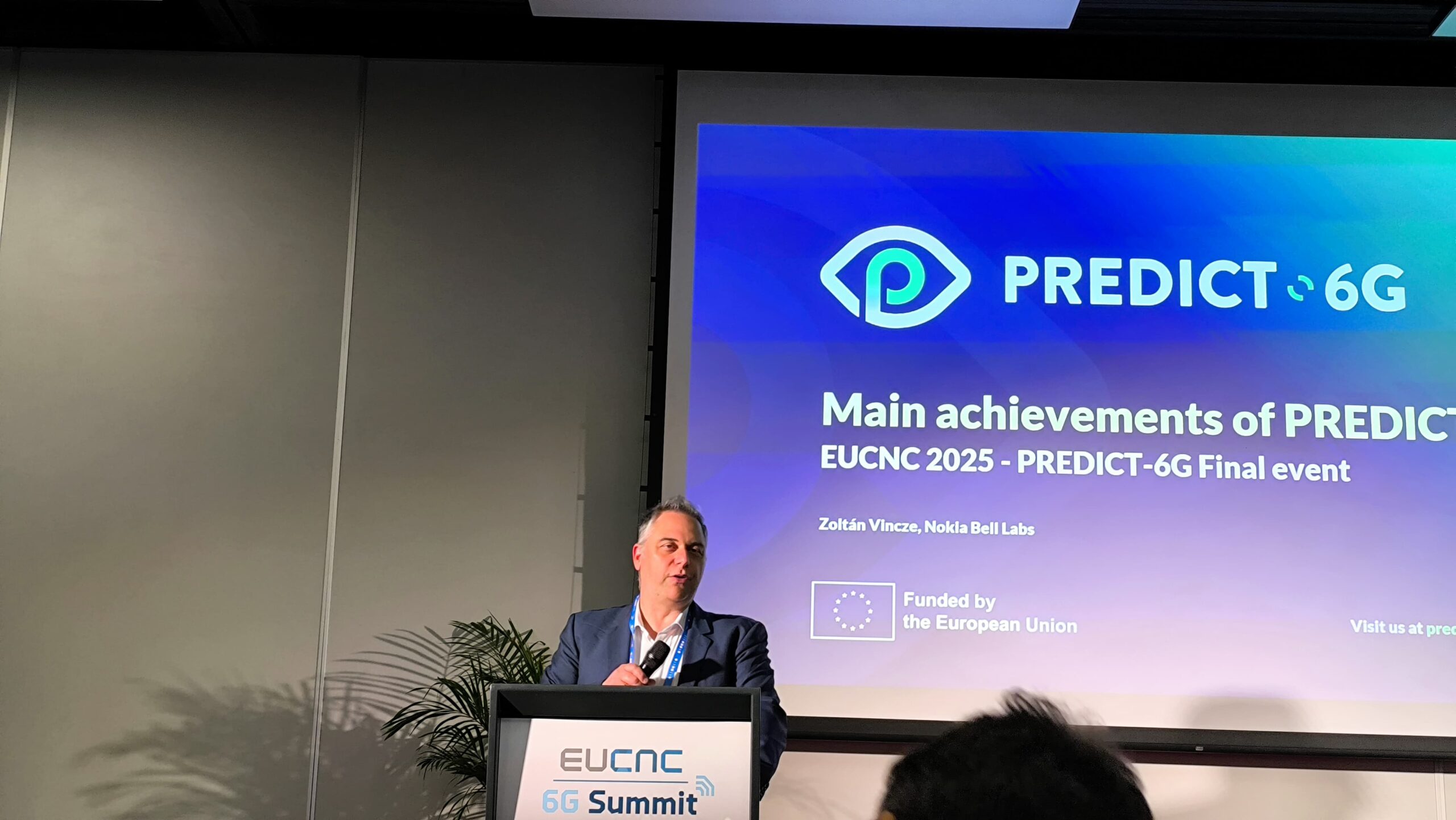
Marc Mollà Roselló from Ericsson and Pietro Giuseppe Giardina from Nextworks provided technical insights, delving into key innovations in the data plane, AI-driven control plane, and network digital twin concepts. The session also included live demonstrations of selected technologies developed within the project, showcasing their readiness for use in the real world.
The Final Event concluded with a panel discussion on the future of dependable networking. The panel, moderated by Valerio Frascolla of Intel and PREDICT-6G Impact Creation Leader, featured expert contributions from Chrysa Papagianni (DESIRE6G), Associate Professor at the Informatics Institute - University of Amsterdam; Joachim Sachs (DETERMINISTIC6G), Senior Expert at Ericsson; Josep Vidal (5GSmartFact), Full Professor at the Universitat Politècnica de Catalunya; and Zoltán Vincze (PREDICT-6G), Senior Research Engineer at Nokia Bell Labs. The discussion touched on cross-project synergies, future research directions, and policy challenges ahead.
In addition to the sessions, the conference offered consortium members a special opportunity to reunite in person, with many doing so for the last time, as the official conclusion of PREDICT-6G approaches at the end of June 2025. The EuCNC & 6G Summit provided a fitting and timely opportunity to reflect on the impactful journey of PREDICT-6G.
If you want to stay updated about PREDICT-6Gt, subscribe to our newsletter and follow us on Twitter, LinkedIn and Bluesky!
PREDICT-6G presents a demo at the Horizon Europe Cluster 4 Info Day
On 22 May, IMDEA Networks, in collaboration with the Centre for the Development of Industrial Technology (CDTI), organised the Horizon Europe Cluster 4 Info Day. The aim of the event was to strengthen the participation of IMDEA Networks in Horizon Europe, encouraging the involvement of Spanish organisations, particularly companies, in the EU Framework Programme.
David Rico, from the Universidad Carlos III de Madrid (UC3M), presented the final results of the PREDICT-6G demonstration titled Real-Time Gesture-Based Remote Control of a Digital Twin. Deployed at the 5TONIC lab, the demo showcases a real Industry 5.0 use case: remote robot control via a digital twin in a realistic industrial environment. It illustrates how 6G networks can provide ultra-reliable, time-sensitive and secure connectivity across different sectors by combining 5G, TSN, Wi-Fi and DetNet technologies.
The demo can be watched here.
If you want to stay updated about PREDICT-6Gt, subscribe to our newsletter and follow us on Twitter, LinkedIn and Bluesky!
Record available - 6G-PD Webinar Series: #3 Next challenges for 6G in deterministic and programmable mobile networks
The third round of the 6G Programmable Deterministic Webinar Series took place on 20 May 2025, under the title ‘Next challenges for 6G in deterministic and programmable mobile networks’.
The 6G Programmable Deterministic Webinar Series: #3 “Next challenges for 6G in deterministic and programmable mobile networks” brought together 88 participants, from researchers to industrials, across 21 different countries. 35 SNS projects attended the webinar.
The session began with a presentation on DETERMINISTIC6G titled 'Lessons from DETERMINISTIC6G and the Way Ahead for 6G’, delivered by James Gross, Professor at KTH. Gergely Pongracz, Expert of programmable networks at Ericsson Hungary concluded the presentations with a talk entitled 'Beyond DESIRE6G: From AI and Cloud-Native to Goal-Native 6G'.
The agenda concluded with an animated discussion with the audience. The webinar was moderated by Antonio de la Oliva, associate professor at the Universidad Carlos III de Madrid and PREDICT-6G’s Project Coordinator.
The presentations are available here.
The recording of the seminar is available here or below.
The 6G Programmable Deterministic Webinar Series is a collaborative initiative between PREDICT-6G, DESIRE6G and DETERMINISTIC6G, aiming to delve into the intricate and transformative aspects of these sister projects, with expert speakers exploring the latest developments and innovations shaping the future of 6G technology. Each session will provide in-depth information and foster key discussions for practitioners and researchers working on the next generation of wireless communications.
PREDICT-6G at ICT 2025
The 31st IEEE International Conference on Telecommunications (ICT2025) took place in Budva, Montenegro, on 28-29 April. This annual conference has become a renowned gathering place for a diverse community of global researchers, engineers and representatives of stakeholders. Covering key areas of telecommunications and the latest ICT and novel technologies driving progress in the field, ICT 2025 facilitated collaboration, discussion and knowledge exchange, while revealing the latest trends and innovations in telecommunications.
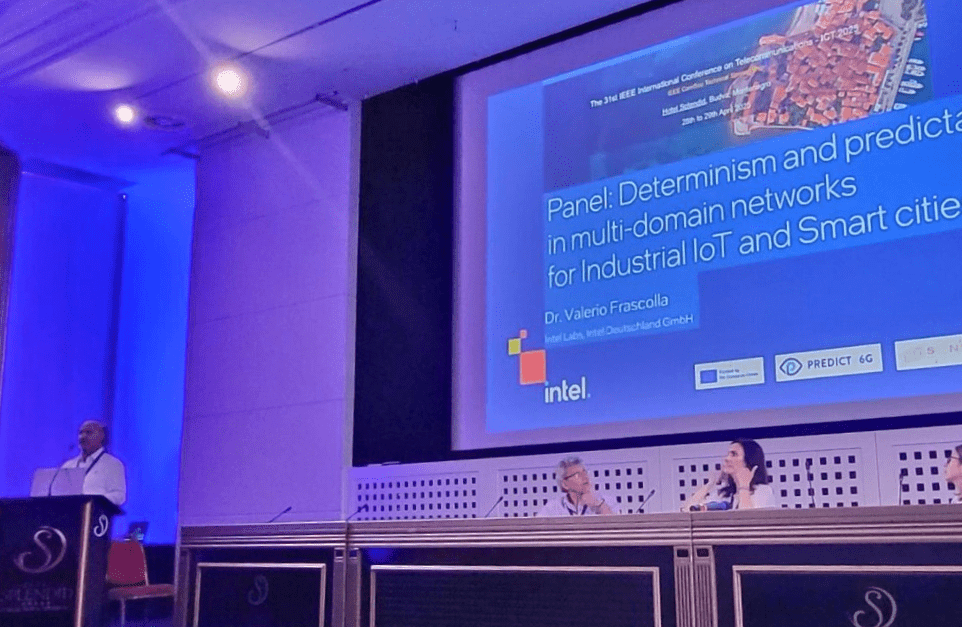
Valerio Frascolla, Director of Research and Innovation at Intel and PREDICT-6G Impact Creation Leader, represented PREDICT-6G at ITC. He presented a paper entitled 'Dynamic spectrum management in multi-access systems towards 6G'. This paper provides a survey of key innovations brought in the last ten years in the areas of both dynamic spectrum management and integration of diverse radio access technologies in heterogeneous and multi-access systems, taking into consideration also regulatory and standardisation aspects. It can be read here.
Valerio also organised the panel 'Determinism and predictability in multi-domain networks for Industrial IoT and smart cities', in collaboration with the MultiX and the 6G-SENSES projects, and he delivered the keynote speech, titled 'Mixed criticality networks in the Industrial Internet of Things'.
If you want to stay updated about PREDICT-6Gt, subscribe to our newsletter and follow us on Twitter, LinkedIn and Bluesky!
6G Programmable Deterministic Webinar Series: #3 Next challenges for 6G in deterministic and programmable mobile networks
We are pleased to announce the 6G Programmable Deterministic Webinar Series, a collaborative initiative between PREDICT-6G, DESIRE6G and DETERMINISTIC6G. This quarterly series aims to delve into the intricate and transformative aspects of these sister projects, featuring expert speakers that will explore the latest developments and innovations shaping the future of 6G technology. Each session will provide in-depth information and foster key discussions for practitioners and researchers dedicated to the next generation of wireless communications.
The third webinar will take place on Tuesday 20 May at 10:00 CET. Under the title ‘Next challenges for 6G in deterministic and programmable mobile networks’, it will feature Marc Mollà from Ericsson, James Gross from KTH University and Gergely Pongracz from Ericsson Hungary.
Agenda:
- “PREDICT-6G: Determinism in multi-domain networks,challenges and future”, by Marc Mollà.
- “Lessons from DETERMINISTIC6G and the Way Ahead for 6G”, by James Gross.
- “Beyond DESIRE6G: from AI and cloud-native towards goal-native 6G”, by Gergely Pongracz.
Register here: https://ec.europa.eu/eusurvey/runner/7f5613e5-f9b5-6d84-8f9b-562d49745687
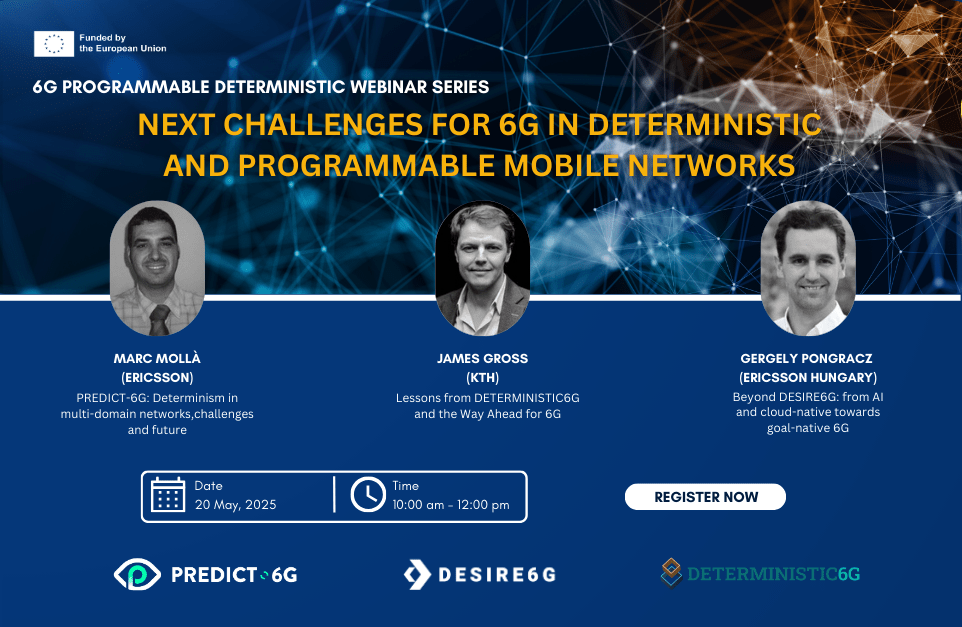
If you want to stay updated about PREDICT-6Gt, subscribe to our newsletter and follow us on Twitter, LinkedIn and Bluesky!
UPCOMING EVENTS
As PREDICT-6G enters its final months, the consortium partners are showcasing the results of the use cases and presenting the latest publications and papers at various events over the coming months. Here is a list so you don’t miss any of the events taking place in 2025.
MPLS & SRv6 AI Net World Congress
The 2025 edition of MPLS & SRv6 AI Net World Congress will take place on 25 - 27 March in Paris, France. The 2025 conference programme will focus on the impact of AI & ML on current infrastructures and services.
Experts will discuss intelligent computing networks, digital twins, software engineering and automation aspects. A large part will be dedicated to IPv6 networks and SRv6 deployments: inter-cluster connectivity, deterministic path placement, IPM hardware connectivity and other key developments. Other sessions will cover IP/optical networks, routing issues, 5G/6G & the edge, latency and security.
Luis Miguel Contreras, technology expert at the Global CTIO Unit from Telefónica, PREDICT-6G partner, will be one of the speakers at the conference. He will participate in the Latency and Performance Measurement session to address the new considerations, such as latency and jitter, required by new services such as VR and AR.
SNS projects join forces in the AI and Security Webinar
In April 2025, PREDICT-6G will participate with several SNS projects in the “AI and Security” webinar. Organised by ELASTIC and CONFIDENTIAL-6G, the online event addresses various aspects of AI and security from different perspectives.
The webinar comprises three main sessions, namely: Privacy and Security in Federated and Distributed AI; AI and Security for Predictive and Resilient Networking; and, Security and Privacy Management in Next-Generation Network Orchestration.
PREDICT-6G partner, Fotis Foukalas from Cognnin, will deliver a presentation titled “Threats and Security Enablers for Predictive 6G Networks”.
Stay tuned for more information!
EuCNC 2025
The 2025 EuCNC & 6G Summit will take place on 3 - 6 June in Poznan, Poland. Combining two successful telecoms conferences: ECNC (European Conference on Networks and Communications), supported by the European Commission, and the 6G Summit, originating from Finland’s 6G Flagship programme, the event is now one of the largest in the sector.
Under the theme 'Towards the 6G World', EuCNC will bring together more than 1000 delegates from over 40 countries around the world and an exhibition with more than 50 exhibitors to demonstrate the technology being developed in this area, notably through research projects from EU R&I programmes. One of these projects will be PREDICT-6G, as we are returning for the third year in a row.
Save the date and stay tuned for more information on this event!
If you want to stay updated about PREDICT-6Gt, subscribe to our newsletter and follow us on Twitter, LinkedIn and Bluesky!
PREDICT-6G at the MWC 2025
MWC Barcelona, the largest and most influential event in the connectivity sector, was held on 03-06 March 2025. It brought together more than 109k attendees from 205 countries and territories and over 2,900 exhibitors, among which was PREDICT-6G consortium member, InterDigital. As in previous years, InterDigital had a strong presence at MWC, with a stand that included, among other things, several demos showing how innovation powers connected experiences at work, at play and at rest.
InterDigital's booth showcased cutting-edge research and industry collaborations, highlighting the potential of 6G to integrate sensor data and AI with wireless communications, pioneering immersive video experiences and solutions to reduce power consumption across devices, and tangible applications of AI to enhance and improve the variety of content and services delivered over wireless. One of these contributions is the PREDICT-6G demonstration called “Novel Data Plane Concept for Deterministic Networking in an ISAC Setting”, which was part of the ‘Integrated Sensing and Communication’ corner of InterDigital’s booth.
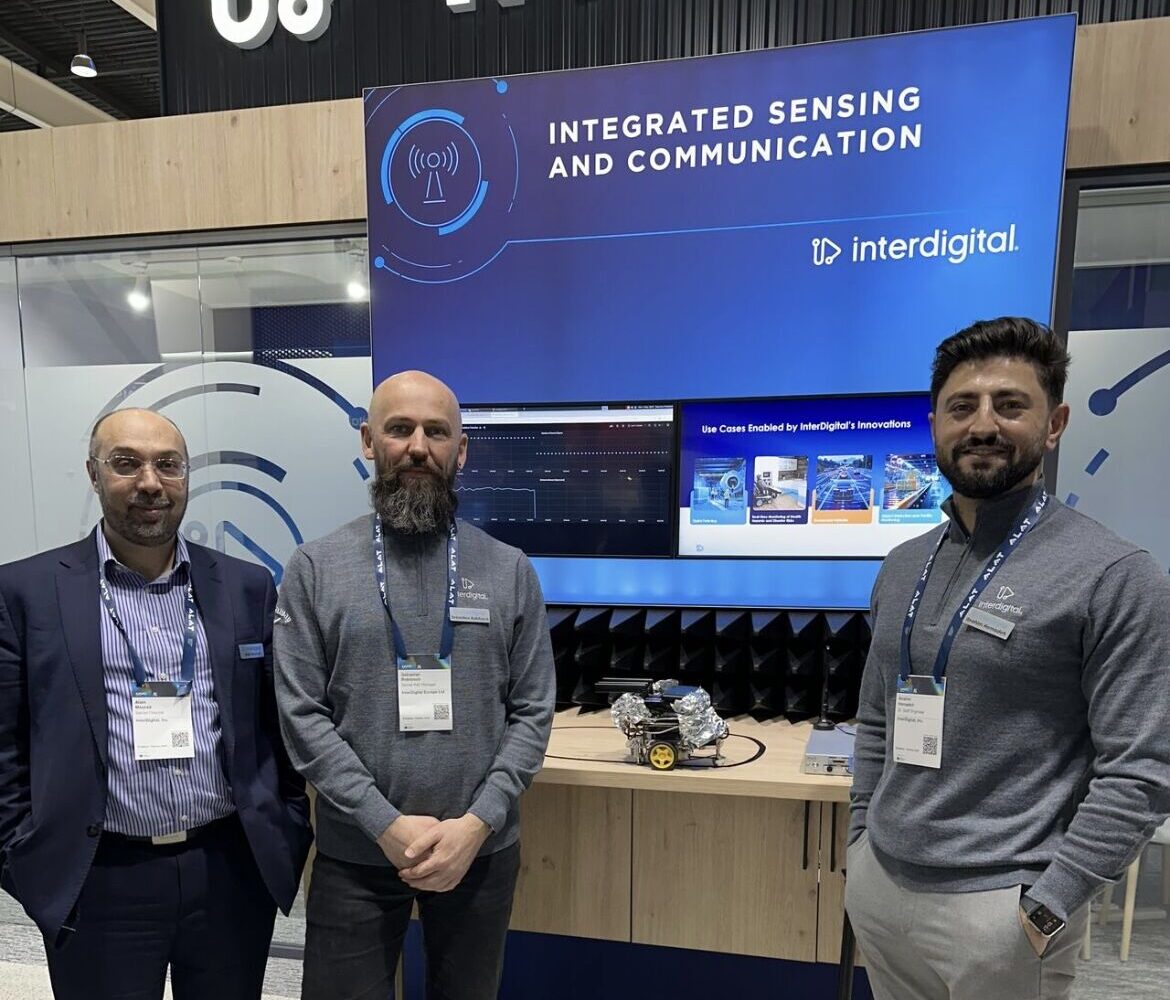
Dr. Sebastian Robitzsch from InterDigital, responsible for the standardisation of PREDICT-6G, showed the project demo to the visitors of the MWC. This demo shows how Integrated Sensing and Communication (ISAC)-enabled 6G networks, supported by AI, can enable an autonomous robot to navigate seamlessly through a smart factory environment, avoiding collisions with objects in its path. ISAC uses sensor data from base stations and user devices to identify a wide range of factors to provide optimal service. The approach also ensures reliable and mission-critical delivery of measurement results to applications by leveraging deterministic networking. It also introduces Protocol Data Unit Set-like support, facilitating end-to-end handling of all IP traffic across multi-domain and multi-technology environments.
If you want to stay updated about PREDICT-6Gt, subscribe to our newsletter and follow us on Twitter, LinkedIn and Bluesky!
Integration Week at 5Tonic Open Lab
From 20 to 24 January 2025, PREDICT-6G held the first Integration Week of the project at the 5Tonic Open Lab in Madrid.
In parallel with the first plenary meeting of 2025, held at the Universidad Carlos III de Madrid (UC3M), PREDICT-6G research and technical partners immersed into a week of work focused on implementing the theoretical framework developed in the past years. The activities were carried out in the 5Tonic Open Lab in Madrid, one of two Open Labs where PREDICT-6G use cases are being tested..
In the final stages of the project, the priority is to seamlessly integrate the various elements comprising the deterministic, secure, modular and interoperable 6G network of PREDICT-6G. For this purpose, partners from Universidad Carlos III de Madrid, Nextworks, Atos, SIMAVI, Universitat Politècnica de Catalunya, InterDigital, Ericsson and Telefónica worked together in the MDP and AICP integration and its application in deterministic communications and smart manufacturing.
As part of the Integration Week activities, some of the partners recorded short tutorials on the work developed during these days.
AICP Integration
Alejandro Calvillo, researcher at UC3M, explains what they have done in terms of AICP integration
Smart Factory use case
Miguel Ángel López Serrano, System Manager at Ericsson, explains the progress they are making in the 'Smart Factory' Use Case.
Multi-Domain use case
David Rico, a PhD student and researcher at UC3M, explains the progress they are making in the 'Multi-Domain' Use Case.
If you want to stay updated about PREDICT-6Gt, subscribe to our newsletter and follow us on Twitter, LinkedIn and Bluesky!
PREDICT-6G first plenary meeting of 2025
The Universidad Carlos III de Madrid (UC3M) hosted the first PREDICT-6G Plenary Meeting of 2025. The consortium partners met in Madrid (Spain) for three days to review the status of the project and align on the work to be done in the remaining six months of the project.
On the 20-22 January 2025, the PREDICT-6G consortium held its latest plenary meeting in the UC3M premises. The agenda started with an overview of the project status by the Technical Director. The consortium discussed the progress made so far in terms of milestones, deliverables and KPIs.
One of the highlights of the meeting was the discussion of the latest developments regarding the AI-driven Multi-stakeholder Inter-domain Control-Plane (WP3) and the Multi-technology Multi-domain Data Plane (WP2), as well as their convergence. It was shown that PREDICT-6G is ready to test the local path calculation that enables E2E deterministic service provisioning and Wi-Fi TSN resource configuration.
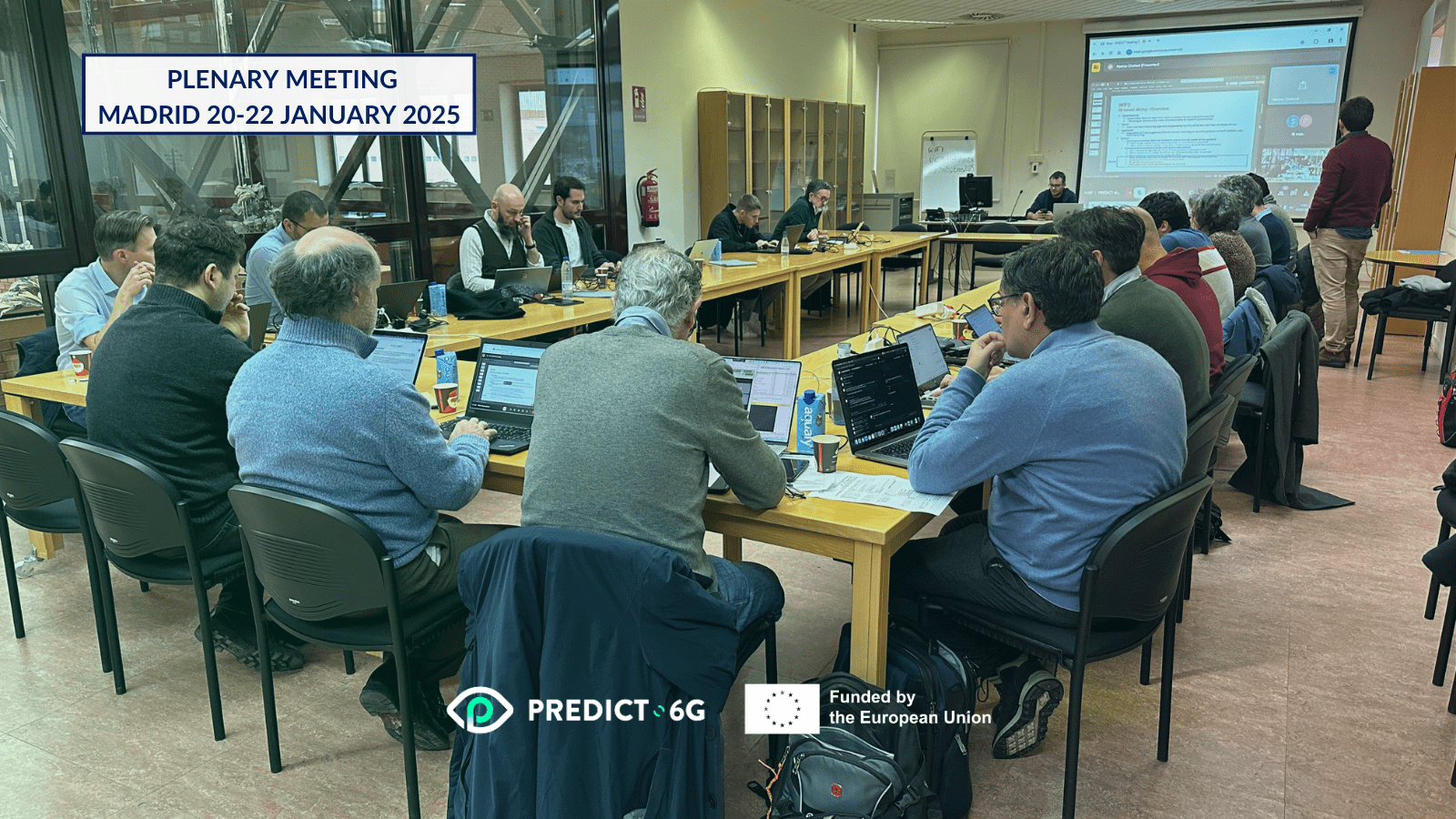
During the following two days, all Work Package Coordinators, supported by the Task Leaders, presented an overview of their activities and achievements, with a special focus on the technical parts that need to be finalised and integrated in the coming months. There was also time for less technical aspects, in particular, the innovation workshop run by Intel, PREDICT-6G Innovation Manager.
The plenary session was very productive. By June 2025, PREDICT-6G will have its secure, modular, interoperable and extensible deterministic 6G network and management framework finished and ready to be presented.
If you want to stay updated about PREDICT-6Gt, subscribe to our newsletter and follow us on Twitter, LinkedIn and Bluesky!

